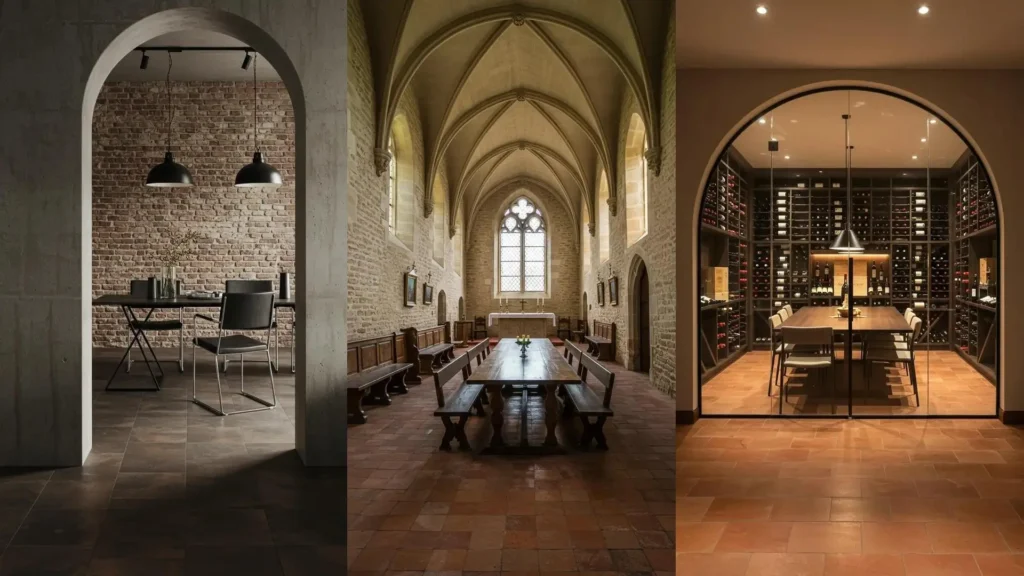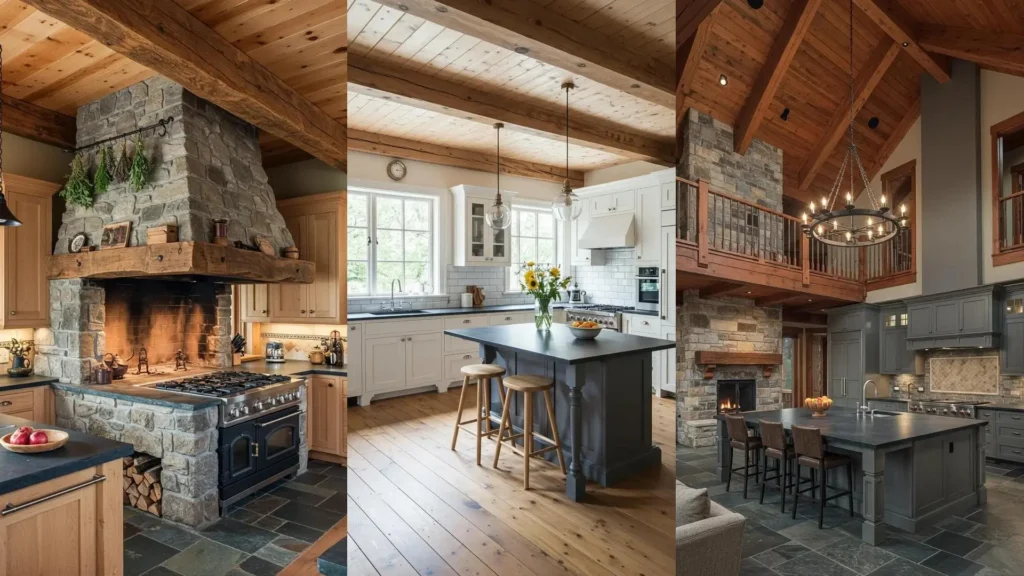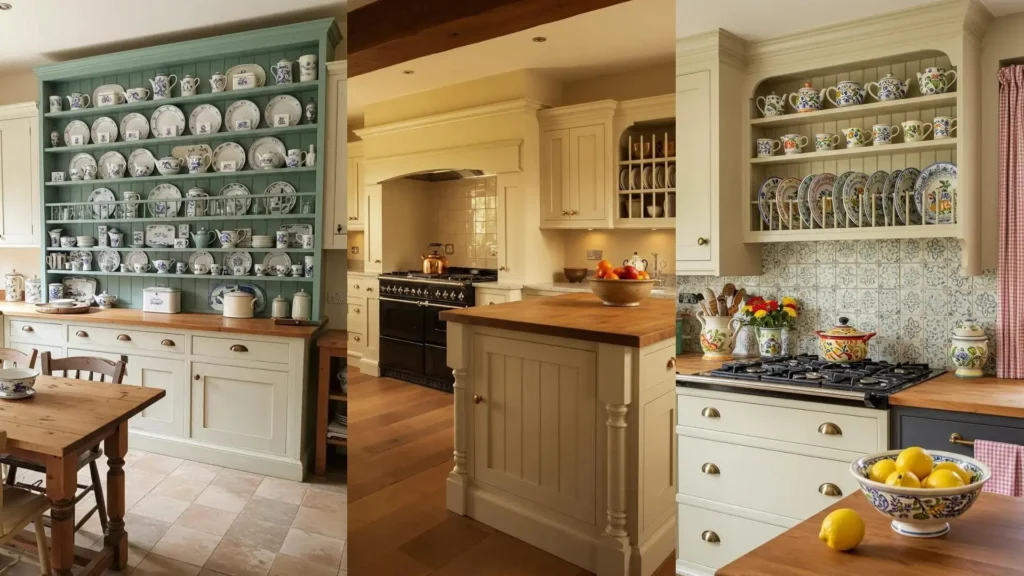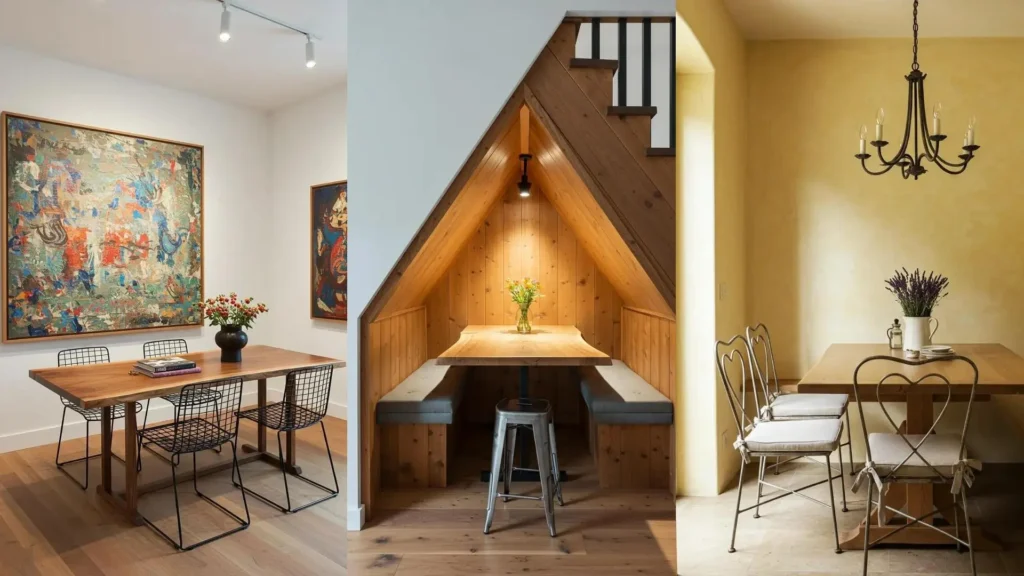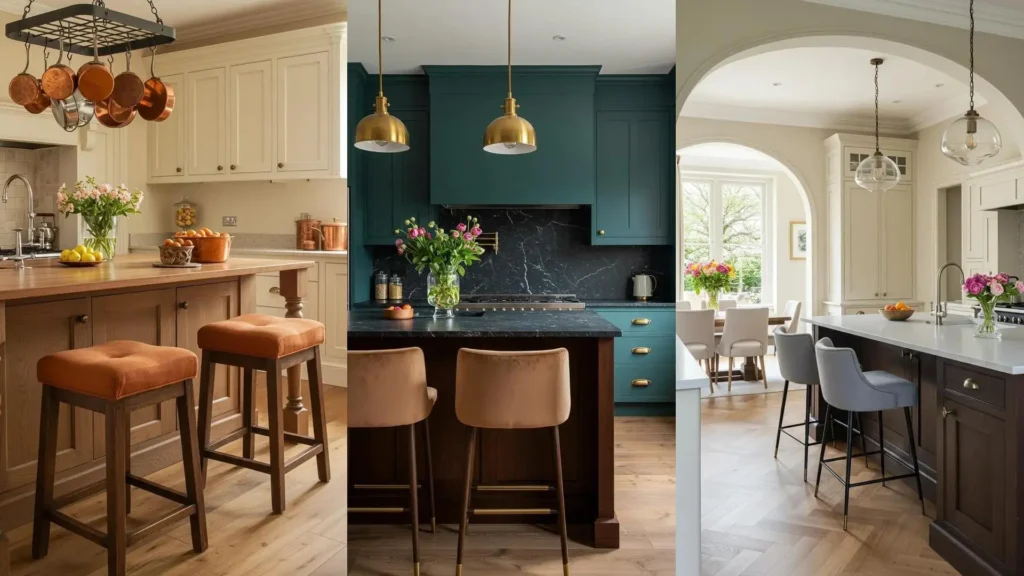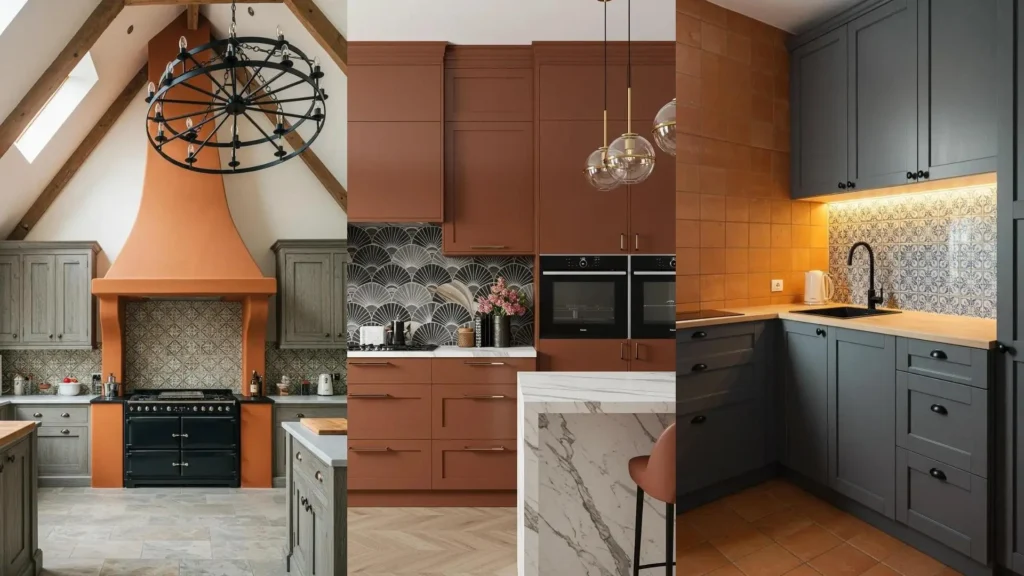A Mediterranean dining room is more than just a place to eat; it’s a space that encourages you to slow down, gather, and connect.
It’s about capturing the warmth of sun-baked terracotta underfoot, the gentle curve of an archway that frames a view, and the simple beauty of natural materials.
You don’t need a villa overlooking the sea to evoke this feeling. It’s about thoughtful choices—embracing texture, celebrating light, and creating a room that feels both ancient and entirely your own. Let’s explore how to bring that timeless elegance into your home.
1. Ground the Room with Rich, Earthen Tones

Embrace the inherent warmth of terracotta floors by pairing them with deep, ochre-washed walls.
This creates a cohesive, immersive feeling that is both grounding and grand.
To prevent the space from feeling too heavy, balance the dark wood ceiling and wrought iron fixtures with the light pouring in from an expansive arched doorway.
If ochre feels too bold, consider a softer sand or creamy off-white to achieve a similar warmth with a lighter touch.
2. Use a Single Color Pop for Coastal Airiness
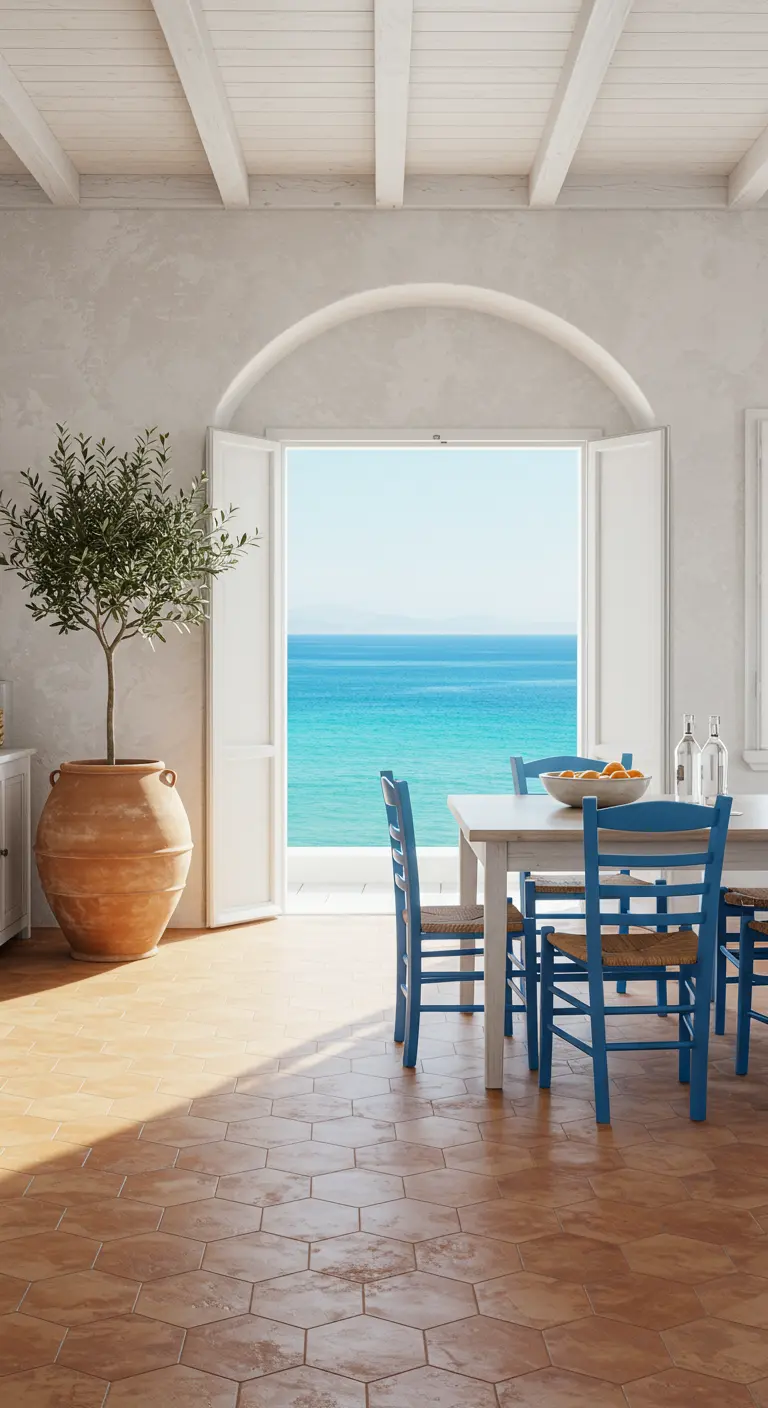
Against a backdrop of whitewashed walls and pale terracotta floors, a splash of vibrant color feels intentional and fresh.
Choose a single, bold hue—like this Aegean blue—for your dining chairs to instantly evoke a Greek island sensibility.
Keep all other elements minimal: a simple white table, a potted olive tree, and clear glassware let the view and the color be the heroes.
This strategy works because it’s simple, confident, and doesn’t clutter the serene atmosphere you want to create.
3. Let Natural Light Sculpt a Textured Space
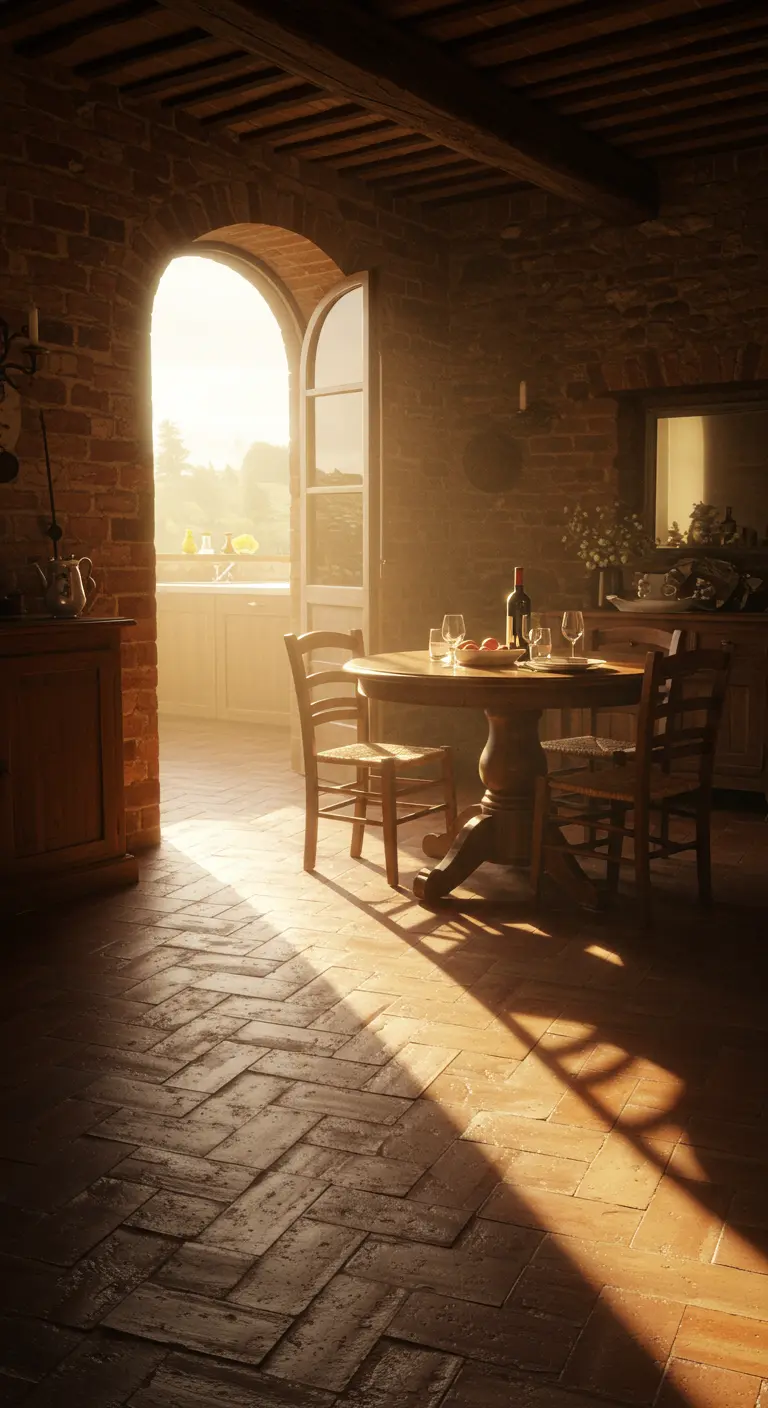
In a room with strong natural materials like exposed brick and reclaimed terracotta, light is your most powerful design tool.
Position your dining table to catch the morning or afternoon sun, allowing its rays to highlight the rich textures of the walls and herringbone-patterned floor.
This creates dramatic shadows and a sense of history, making the room feel alive.
For a similar effect without structural brick, consider a high-quality brick veneer accent wall, which adds texture and character with less commitment.
4. Modernize with a Calm, Monochromatic Palette
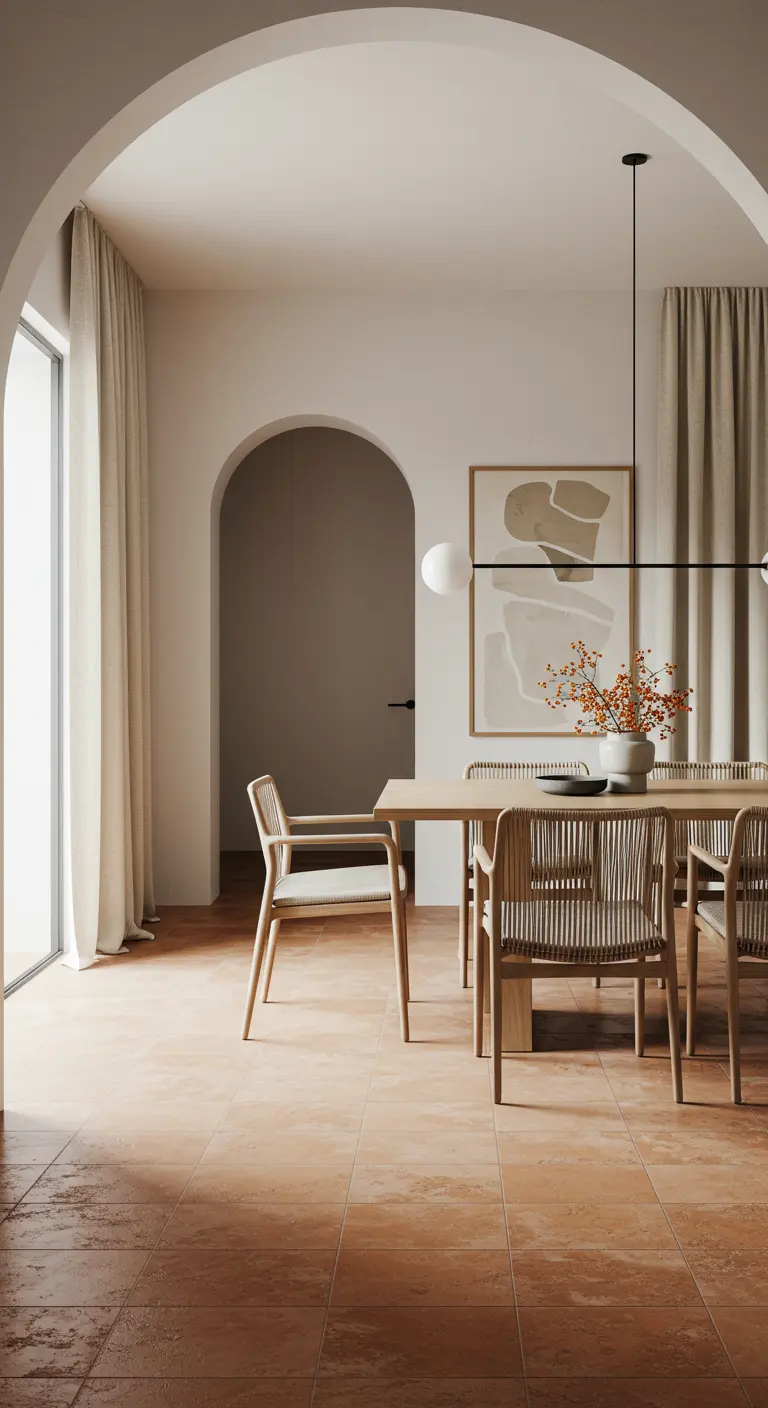
A Mediterranean look doesn’t have to be rustic; it can be incredibly sleek and modern.
Pair your terracotta floors with soft, neutral walls, light wood furniture with clean lines, and unadorned, floor-length curtains.
The arches provide the classic shape, while the minimalist furnishings and modern linear chandelier keep the space feeling current and serene.
This approach proves that the soul of Mediterranean design lies in its architectural forms, which can be beautifully paired with contemporary and minimal aesthetics.
5. Commit to Drama with Jewel Tones & Low Seating
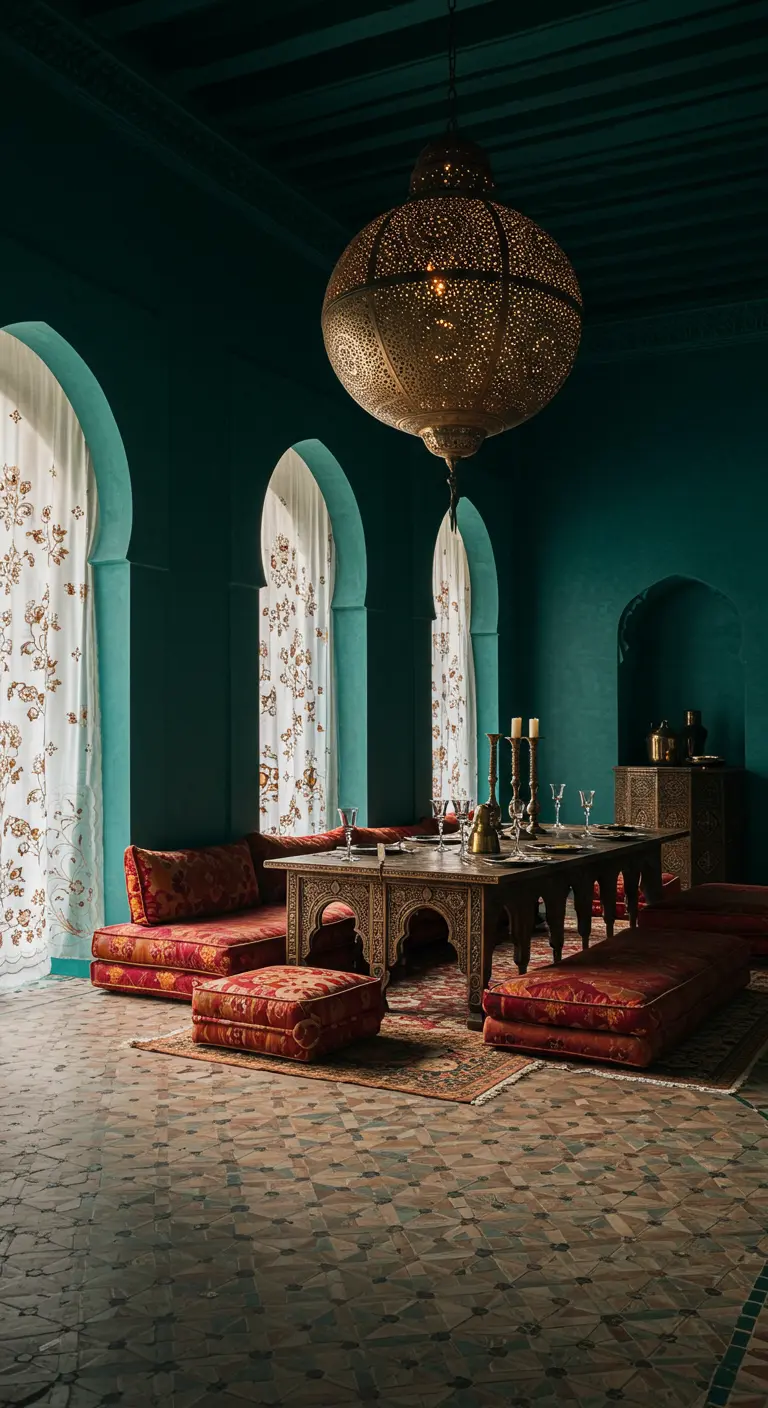
For a truly transportive dining experience, look to Moroccan interiors for inspiration.
Paint your walls a deep, moody teal or emerald and furnish the room with low, intricately carved tables and plush floor cushions in rich reds and oranges.
An oversized, perforated brass lantern is non-negotiable; it casts a magical, dappled light that transforms the entire room.
This style is about total immersion, using color, pattern, and light to create an unforgettable atmosphere.
6. Frame the View Like a Living Painting
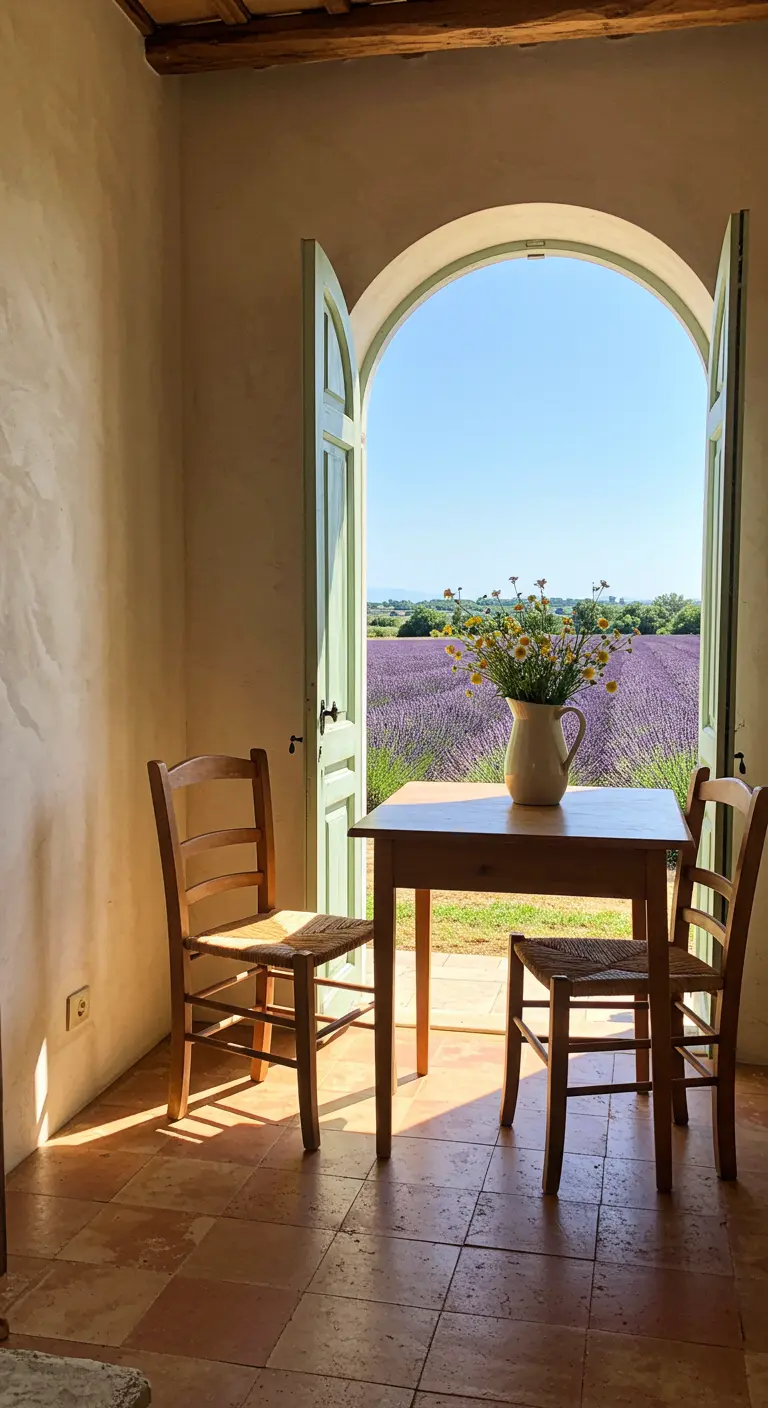
When your dining room opens onto a spectacular view, your primary job is to frame it, not compete with it.
Keep the interior incredibly simple: classic wooden chairs with rush seats, a small, unadorned table, and neutral walls.
The arched doorway becomes the frame for your “living art.”
Even a simple bouquet of wildflowers on the table should feel like it was gathered from the landscape just beyond the door.
7. Define Zones with an Architectural Arch
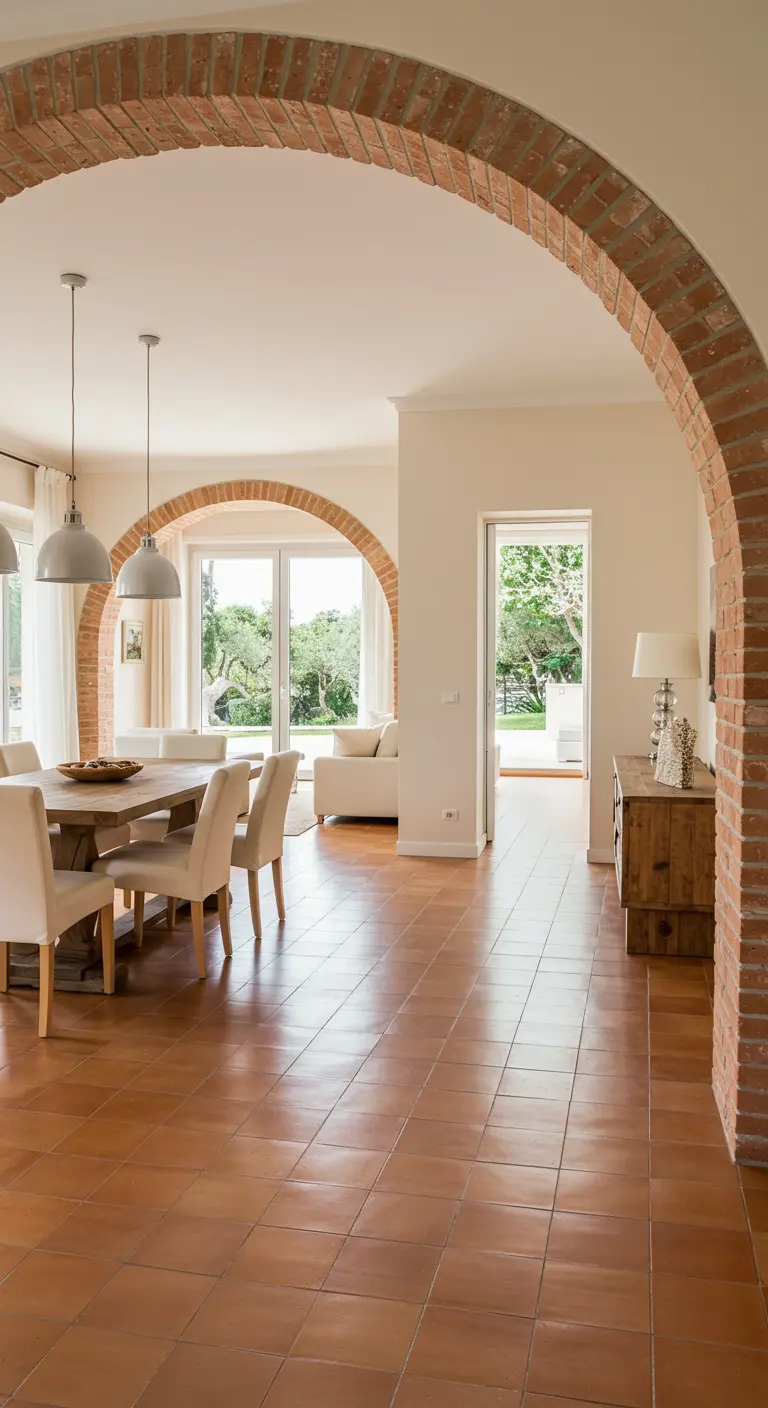
In an open-plan home, a structural arch is one of the most elegant ways to delineate space without sacrificing light or flow.
Here, a brick archway signals the transition from a passageway to the dining and living areas, creating a distinct “room” feel.
This is more sophisticated than simply changing flooring or painting an accent wall, as it uses architecture to guide the experience of the space.
It’s one of the most effective ways to define spaces while maintaining an open, airy connection.
8. Tell a Story with Thematic Tilework
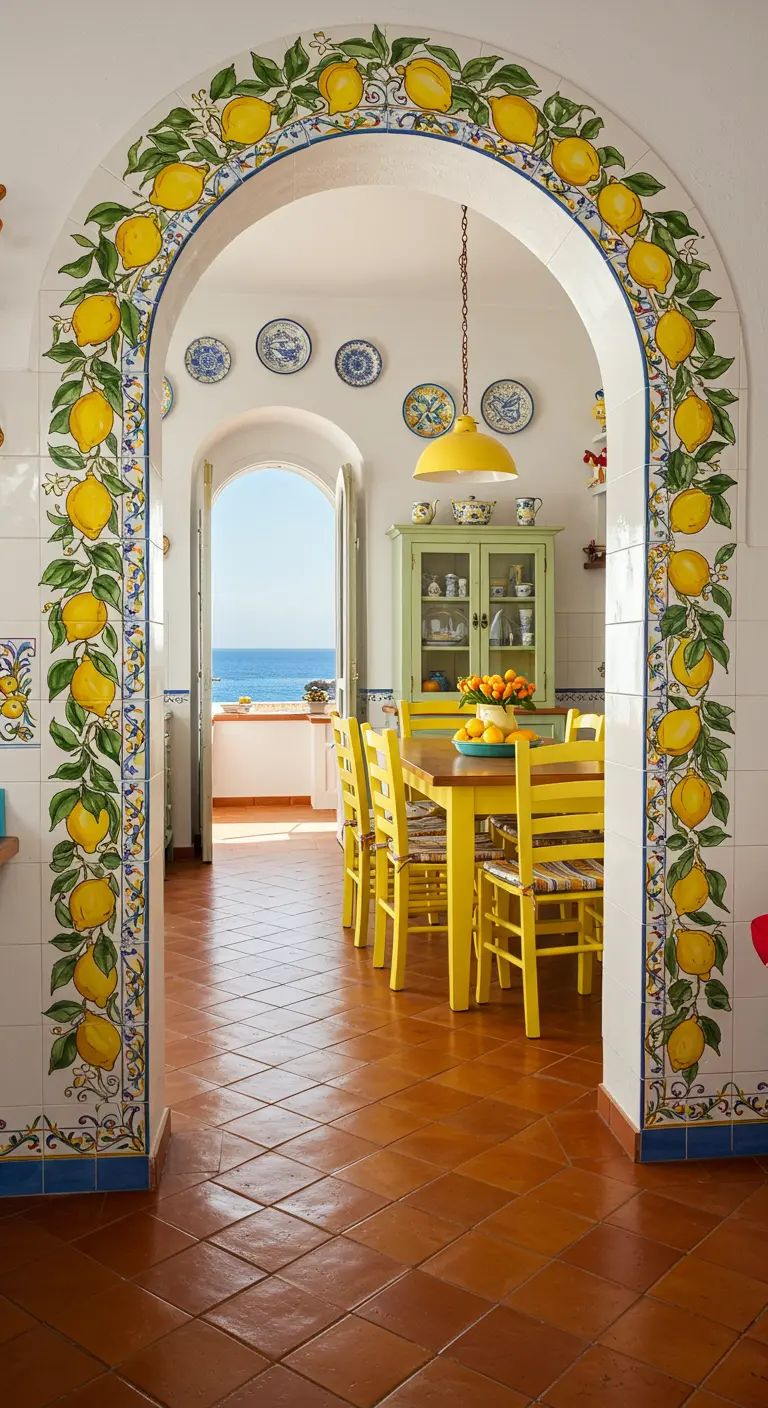
Turn an ordinary archway into a work of art by framing it with hand-painted tiles.
This lemon-motif tile border injects personality and a joyful, sunny character that is quintessentially Amalfi Coast.
Echo the theme by pulling a color from the tile—in this case, bright yellow—for the dining chairs and pendant light, unifying the entire scene.
For a dose of similar charm, consider adding citrus-themed decor to your table for a pop of color.
9. Create Intimacy with Layered Candlelight
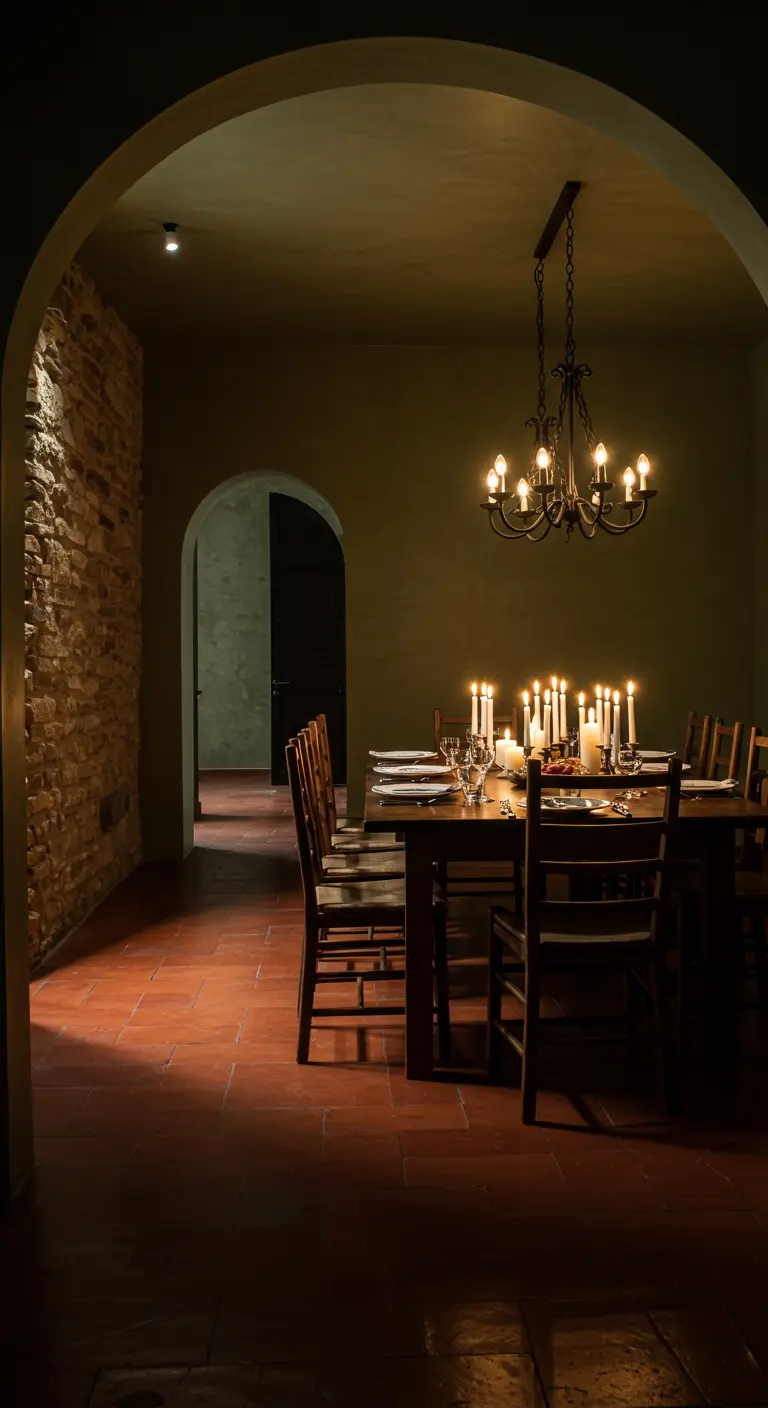
In a dining room with historic character, lean into the moodiness with a lighting scheme dominated by candles.
A classic wrought-iron chandelier provides ambient light, but the real magic comes from clusters of pillar and taper candles on the table.
The flickering flames create soft, dancing shadows on the stone walls, fostering a sense of intimacy and timelessness that overhead lighting alone cannot achieve.
For gatherings, this approach to romantic, candlelit tablescapes makes any meal feel like a special occasion.
10. Soften the Space with Bohemian Textures
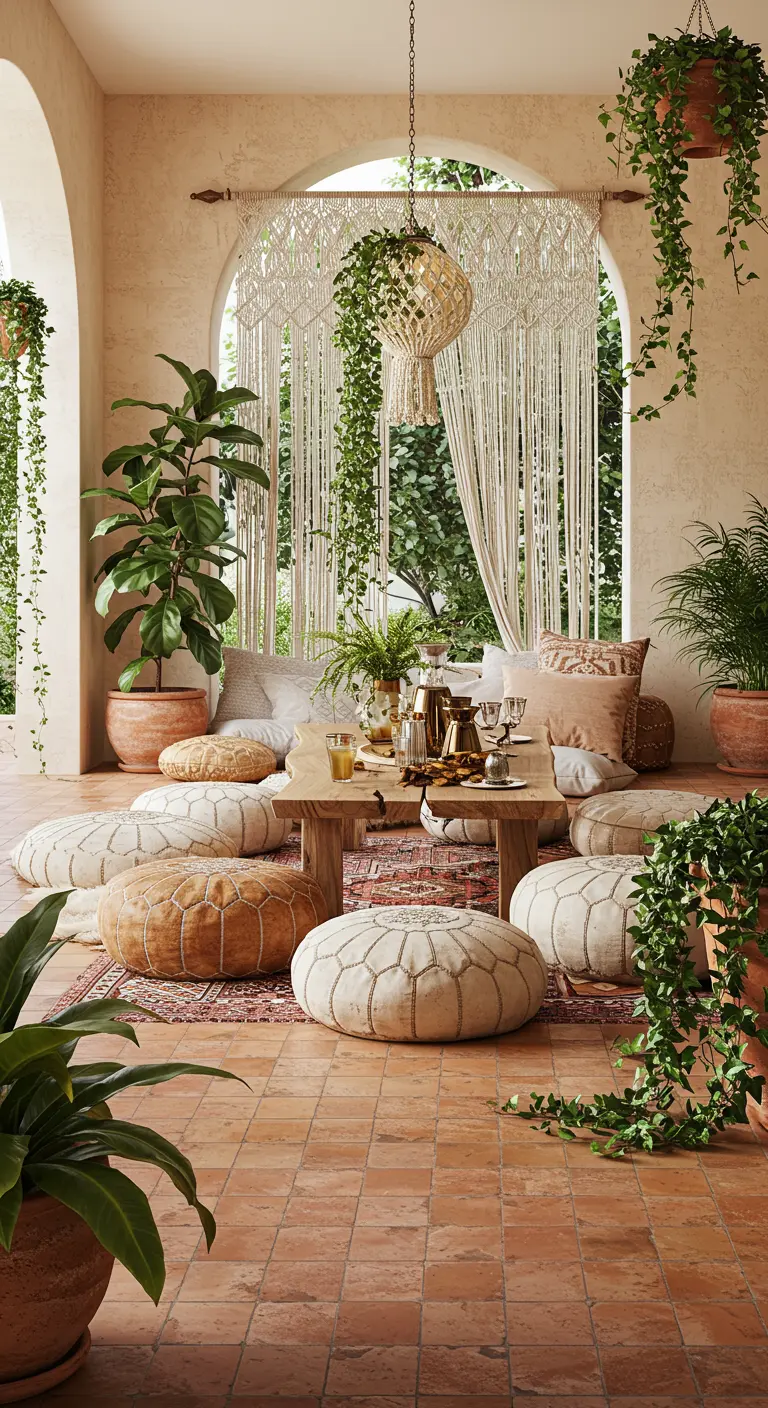
Introduce a relaxed, bohemian vibe to your Mediterranean space by layering in natural, touchable textures.
Swap traditional dining chairs for a mix of floor poufs and cushions, anchored by a vintage-style rug.
Instead of a solid door, frame the archway with a macrame curtain, which filters light beautifully and adds intricate detail.
Potted plants at varying heights are essential to this look, blurring the line between indoors and out and completing these textured bohemian nooks.
11. Make a Statement with Patterned Flooring
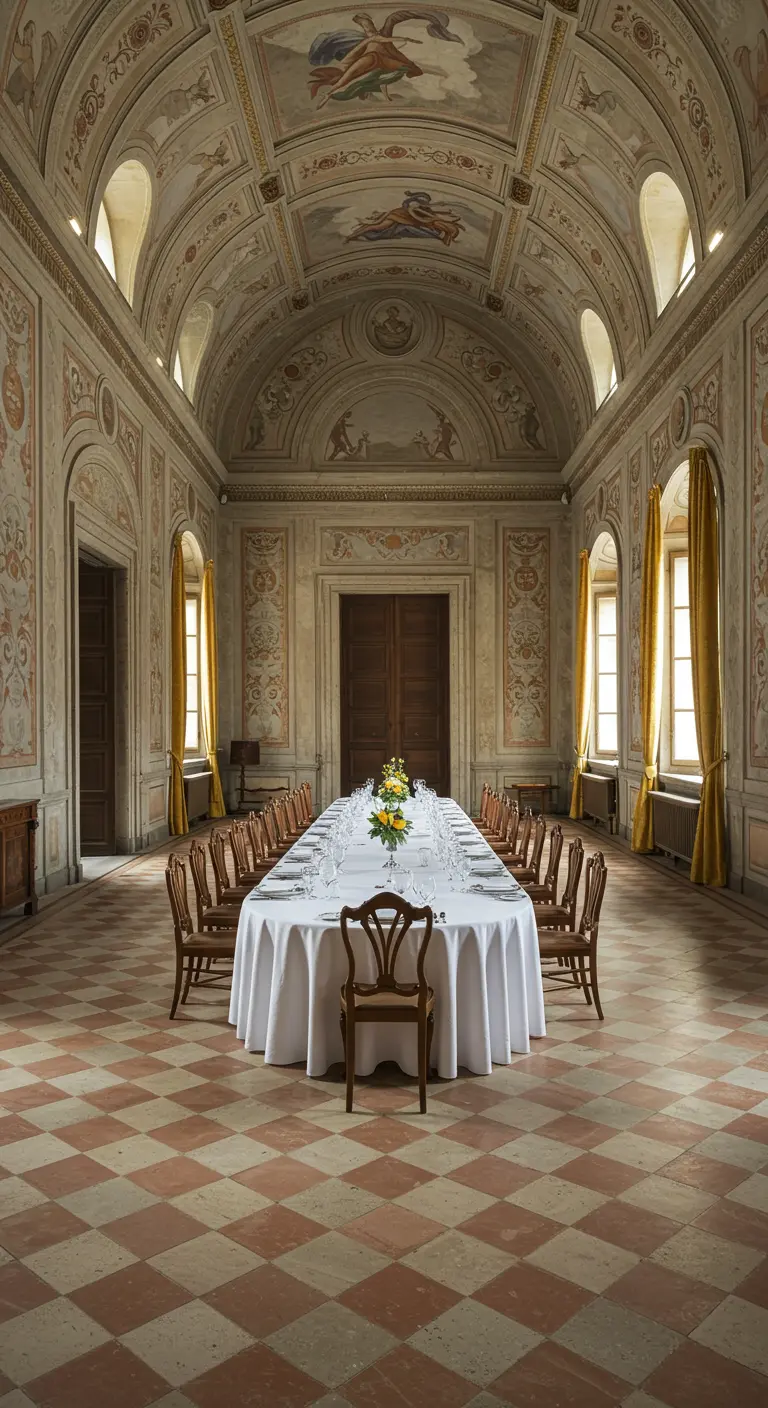
In a room with soaring ceilings and grand proportions, the floor is your fifth wall and a prime opportunity for impact.
A checkerboard pattern in terracotta and cream tiles grounds this palatial space, adding rhythm and visual interest that balances the ornate, frescoed ceiling.
Keeping the table linens and chairs simple allows the room’s two main features—the ceiling and the floor—to shine without competing.
While less common in homes, a classic checkerboard floor is a timeless choice that adds instant gravitas.
12. Embrace Sculptural Simplicity
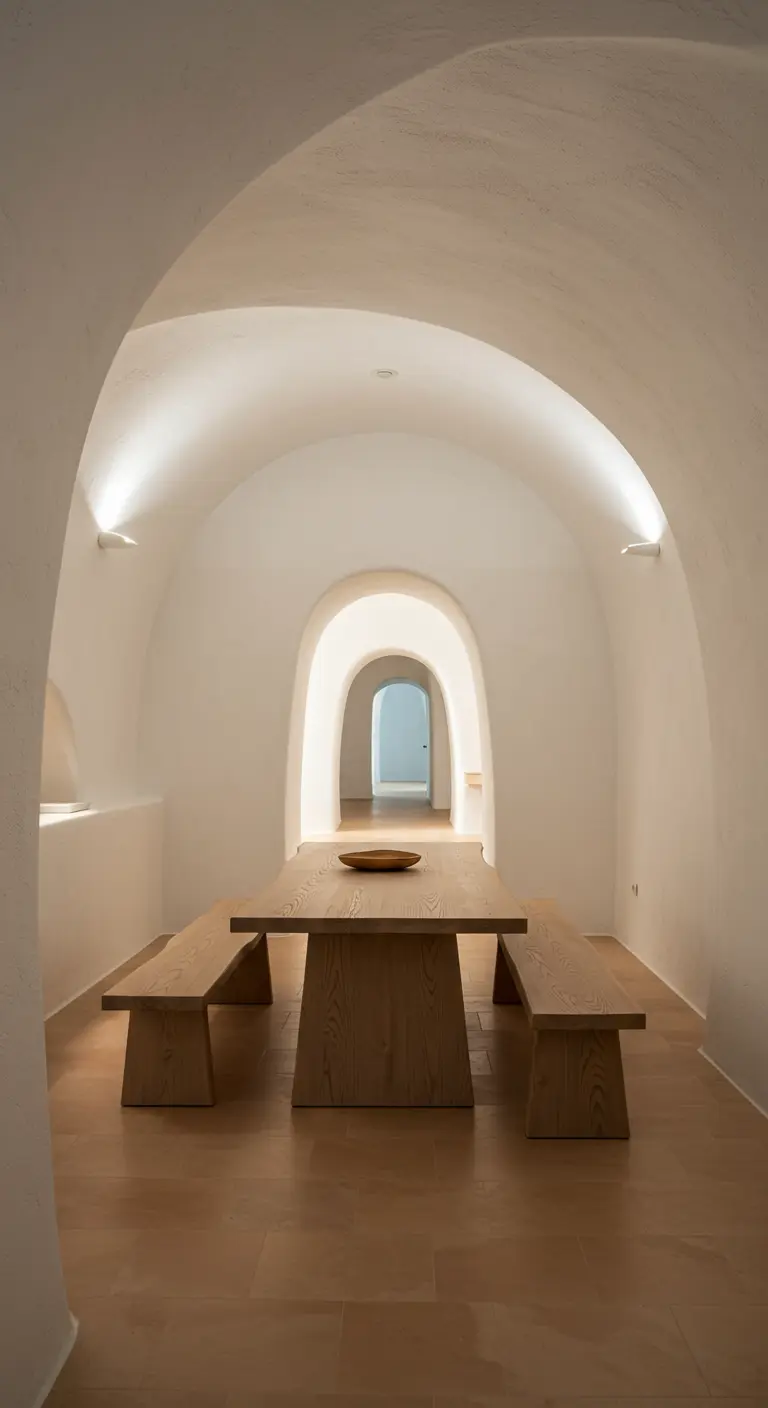
Channel the minimalist aesthetic of the Cyclades with sculptural, whitewashed walls and organic forms.
The beauty here is in the seamless curves and the interplay of light and shadow, creating a cave-like sanctuary.
Furnishings should be elemental and pure in form—a solid wood table and benches with clean, strong lines.
The focus is on shape and material, a serene look that feels both ancient and utterly modern, much like you’d find in Scandinavian minimalist design.
13. Pair Modern Pendants with Classic Arches
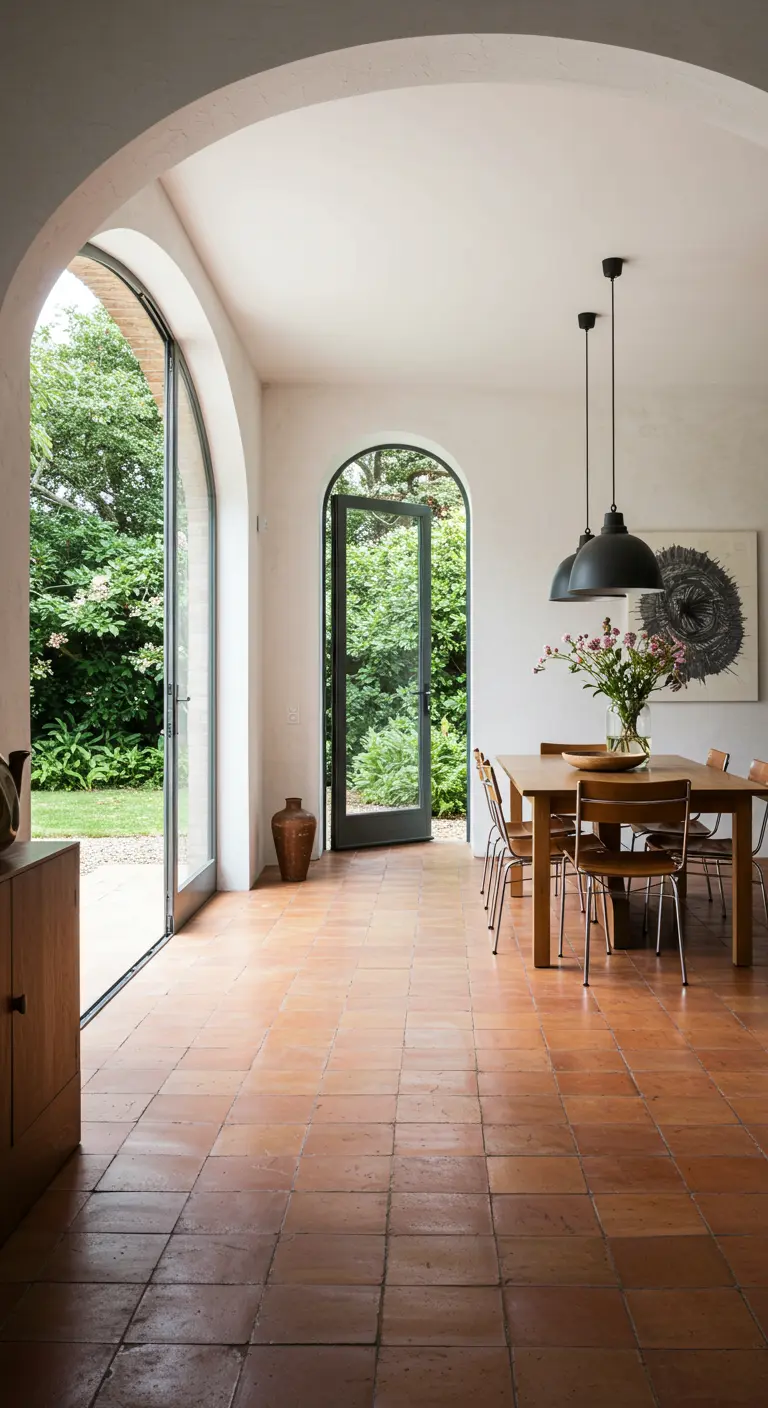
Create a compelling style contrast by hanging modern, industrial-style pendant lights in a room with classic Mediterranean architecture.
The clean, dark forms of the pendants stand out against the soft, white walls and terracotta floors, creating a sophisticated focal point over the dining table.
This pairing demonstrates that you don’t have to choose one style; mixing eras thoughtfully results in a space that feels curated and personal.
Good lighting tricks like this instantly update a room.
14. Anchor the Room with a Monumental Fireplace
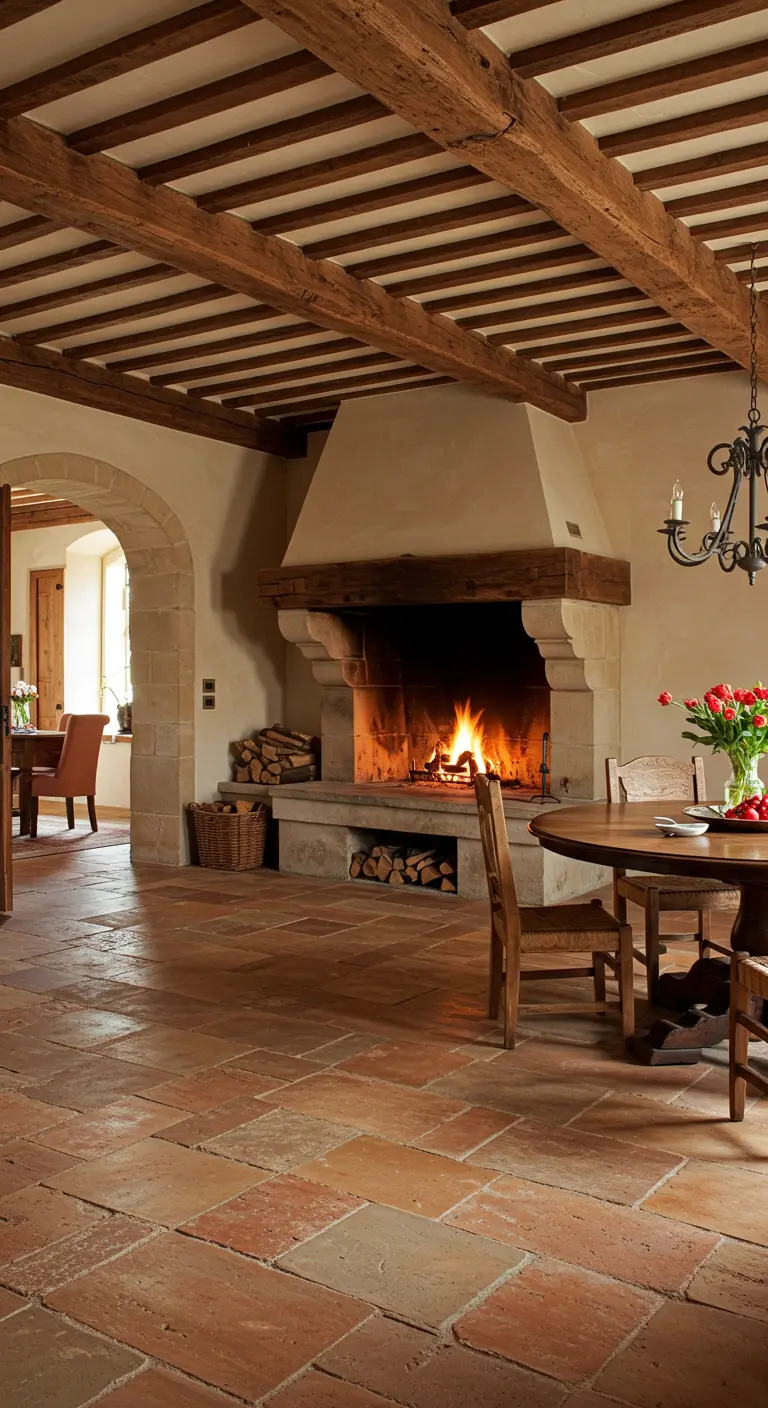
In a rustic Mediterranean home, the fireplace is the heart.
Make it a truly monumental feature, with a commanding presence, a substantial timber mantel, and integrated firewood storage.
This not only provides physical warmth but also acts as a powerful visual anchor for the entire open-plan space, drawing people together.
It’s a core element of the rustic lodge aesthetic, promising comfort and conviviality.
15. Fuse Industrial Edge with Mediterranean Warmth
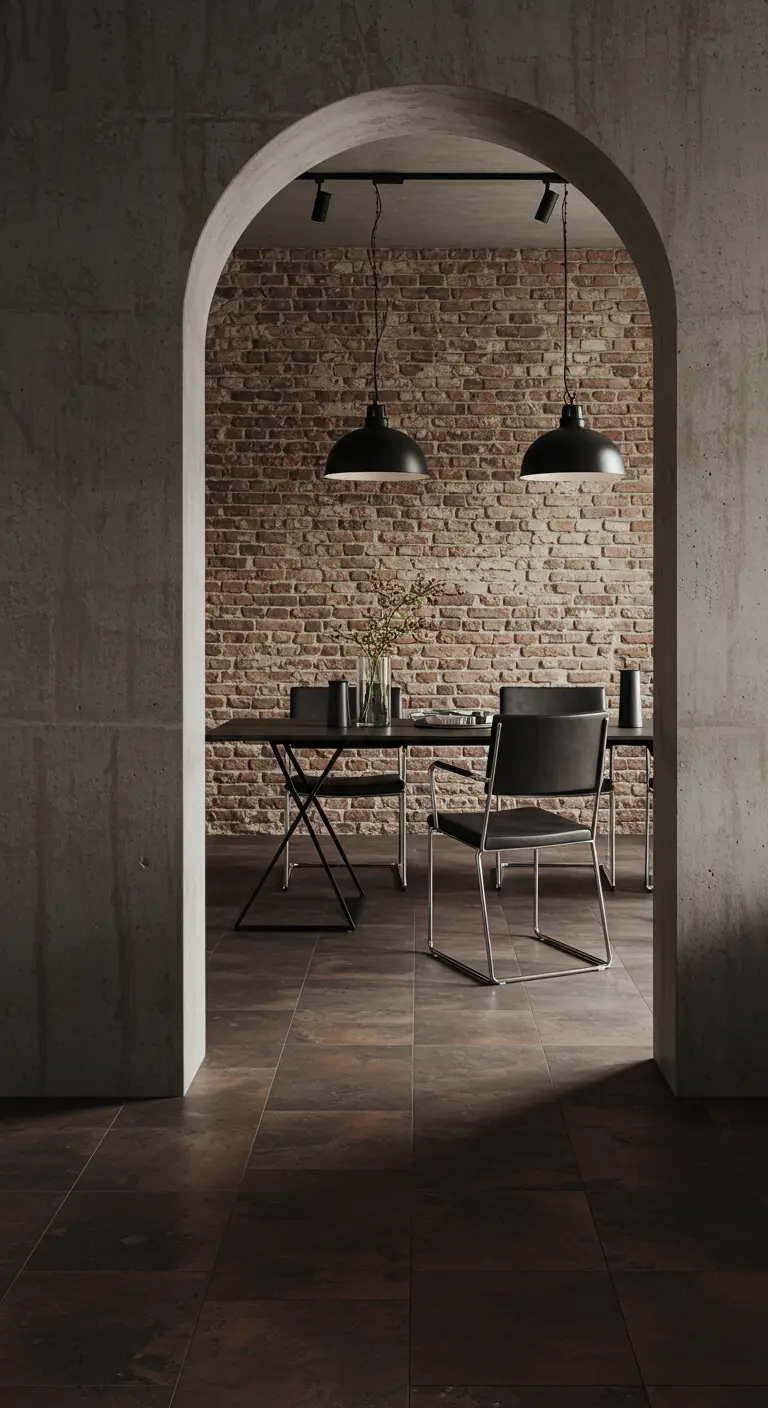
Explore a compelling hybrid style by combining raw, industrial elements with the classic Mediterranean arch.
Frame a view of an exposed brick wall with a rough concrete archway, and furnish the dining space with black metal and sleek leather chairs.
The contrast between the cool, hard surfaces and the warm, earthy tones of the brick and tile creates a look that is both edgy and inviting.
This is a perfect example of industrial-chic interiors given a unique, sun-drenched twist.
16. Soften with Slipcovers and Personal Touches
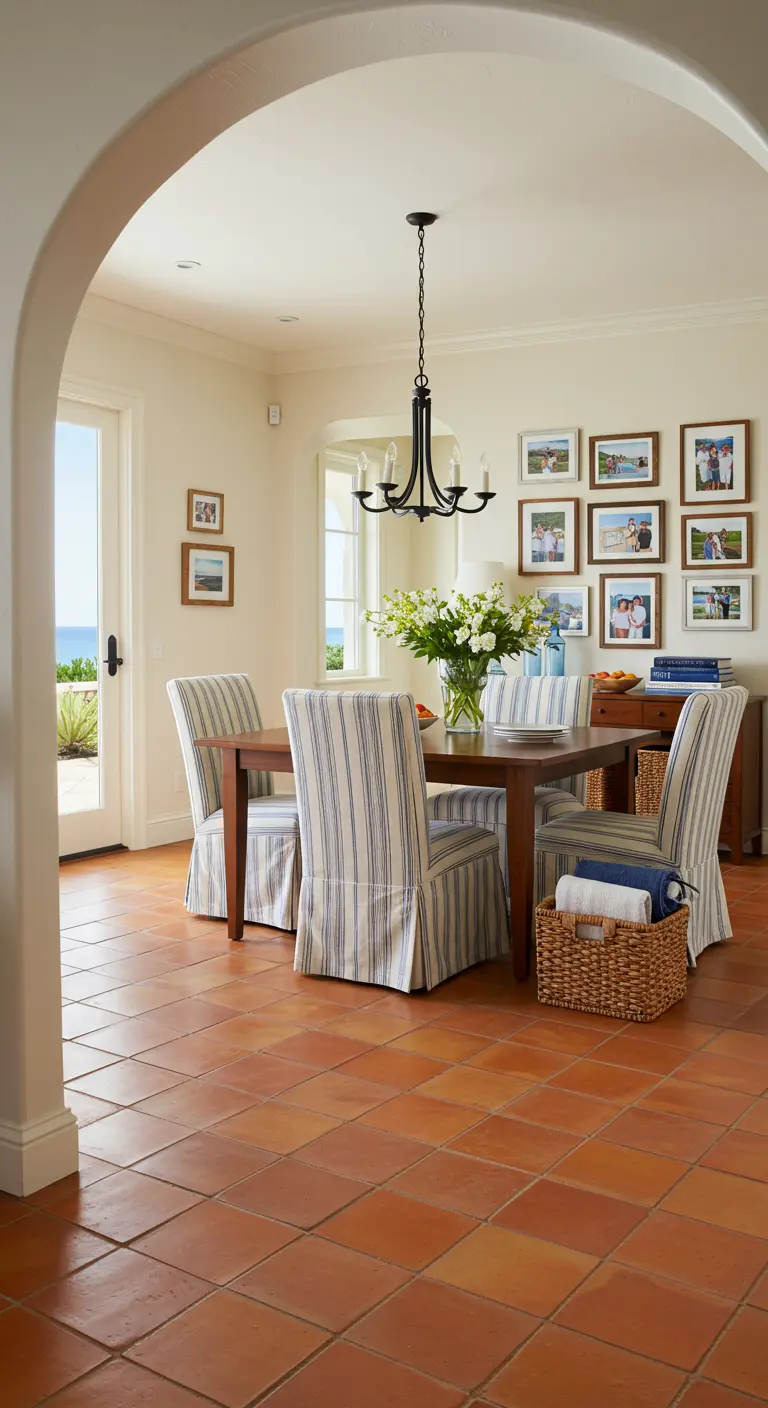
Create a relaxed, approachable coastal feel by using tailored slipcovers on your dining chairs.
A simple blue and white stripe adds a touch of classic, breezy style that beautifully complements the warm terracotta floors.
Soften the formality of a dining room by adding a casual gallery wall of personal photos in simple wood frames, making the space feel like a true family hub.
This combination is central to the coastal farmhouse look, which prioritizes comfort and personal history.
17. Introduce Glamour with Jewel Tones and Brass
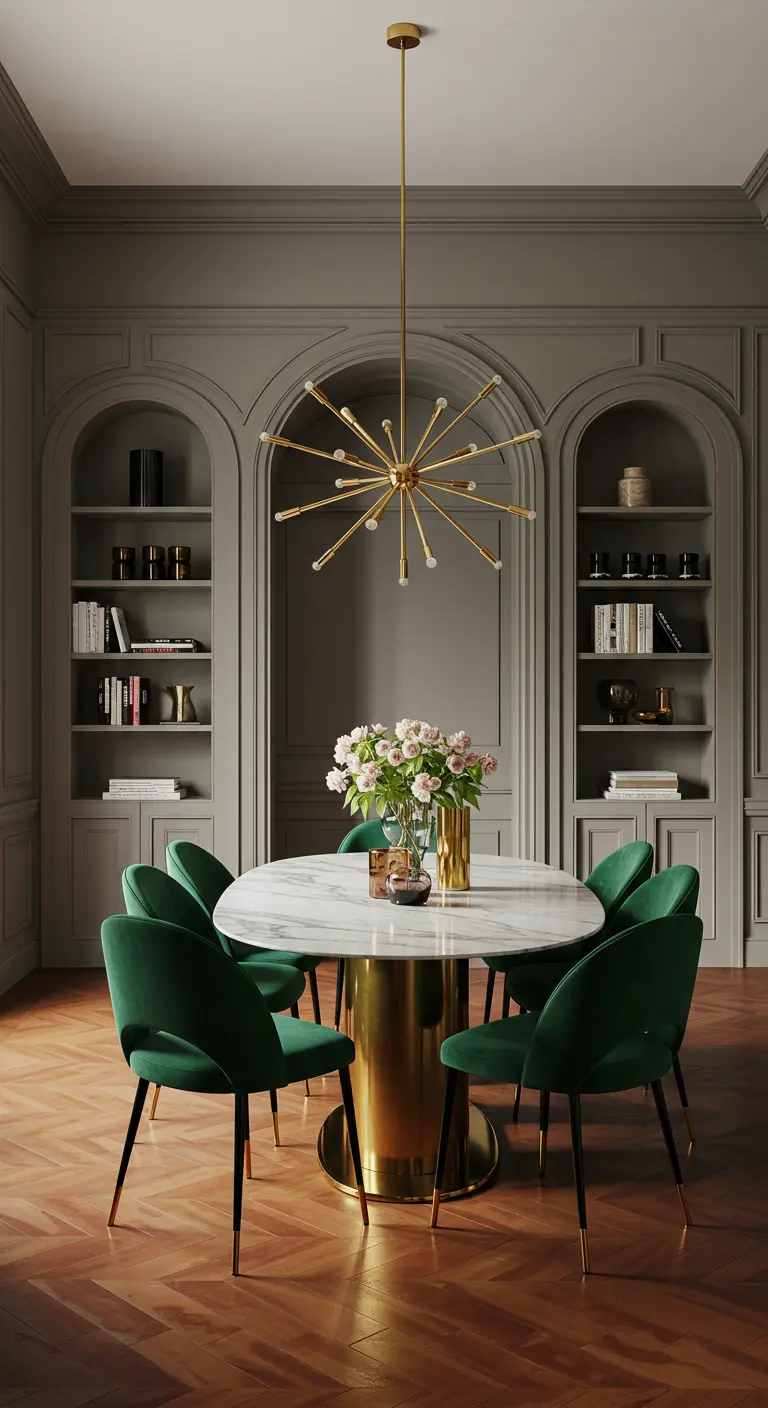
Elevate a classic room by incorporating elements of Art Deco glamour.
Pair traditional arched niches with a striking brass sputnik chandelier—a sculptural piece that acts as jewelry for the room.
Deep emerald green velvet chairs add a luxurious texture and a rich pop of color that feels both sophisticated and bold against the muted grey walls.
This is a hallmark of Art Deco revival: combining geometric forms with opulent materials.
18. Honor History with Monastic Simplicity
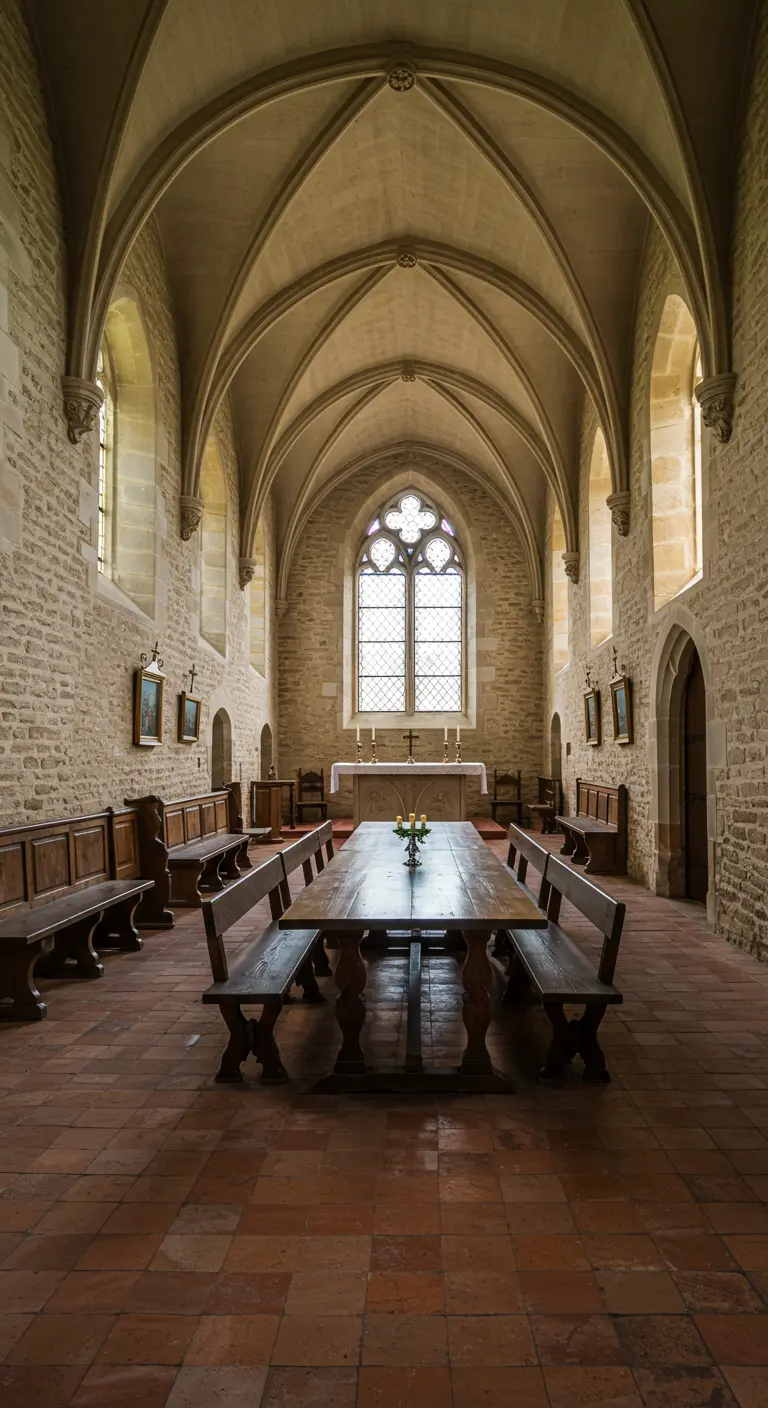
When your dining room possesses incredible historic bones like vaulted stone ceilings and Gothic arches, the best approach is restraint.
Choose simple, almost monastic furniture, like a long, dark wood refectory table and benches, that honors the room’s original purpose and character.
The grandeur comes from the architecture itself; your role is simply to furnish it for modern use without overshadowing its soul.
This style shares a sensibility with Dark Academia interiors, which value history and atmosphere.
19. Create Softness with Billowing Curtains
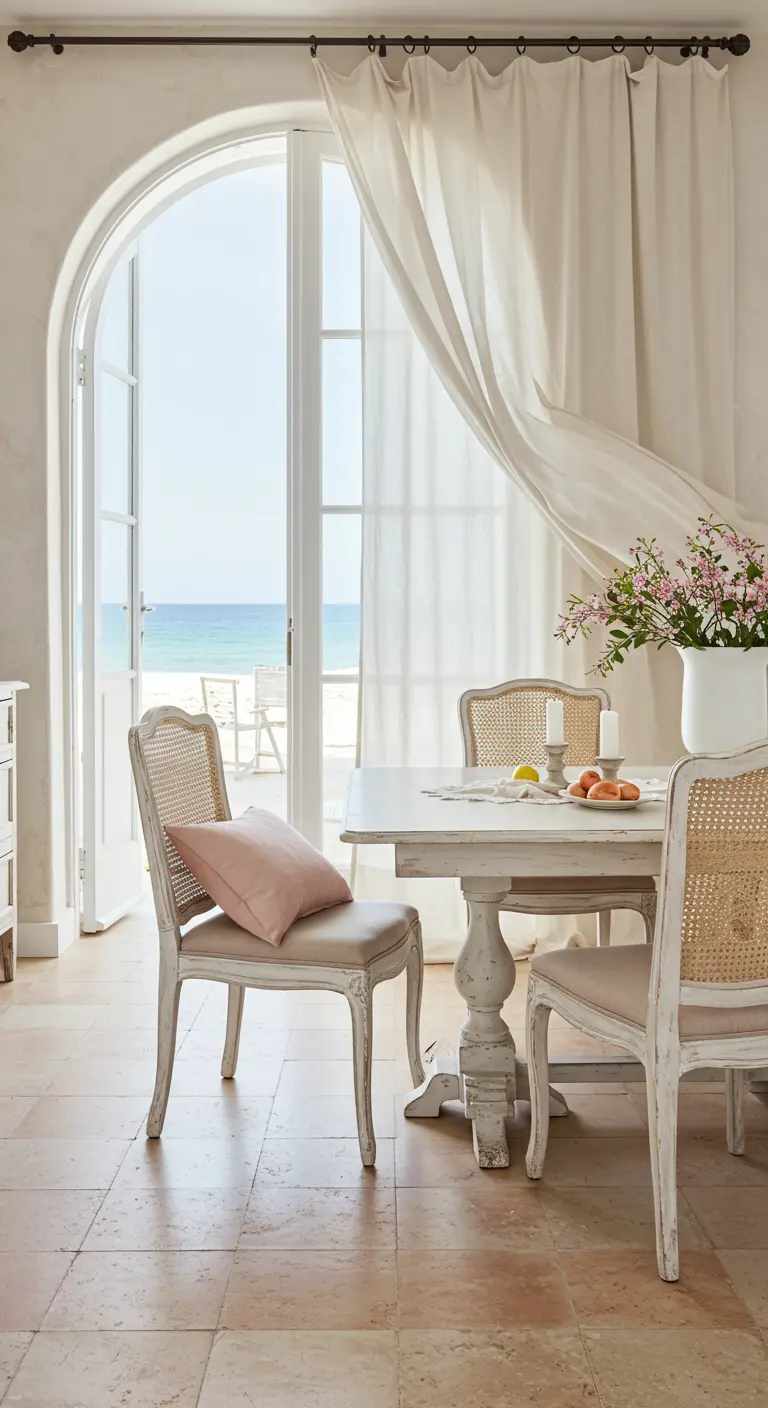
Instantly add romance and movement to your dining space with lightweight, billowing curtains.
Hung high and wide on a simple iron rod, these sheer drapes diffuse harsh sunlight into a soft, ethereal glow and catch the breeze from an open door.
They soften the hard lines of the architecture and tile floors, adding a layer of delicate texture.
It’s a simple but transformative element in any romantic interior, making the room feel more graceful and alive.
20. Embrace Joyful Maximalism with Color and Pattern
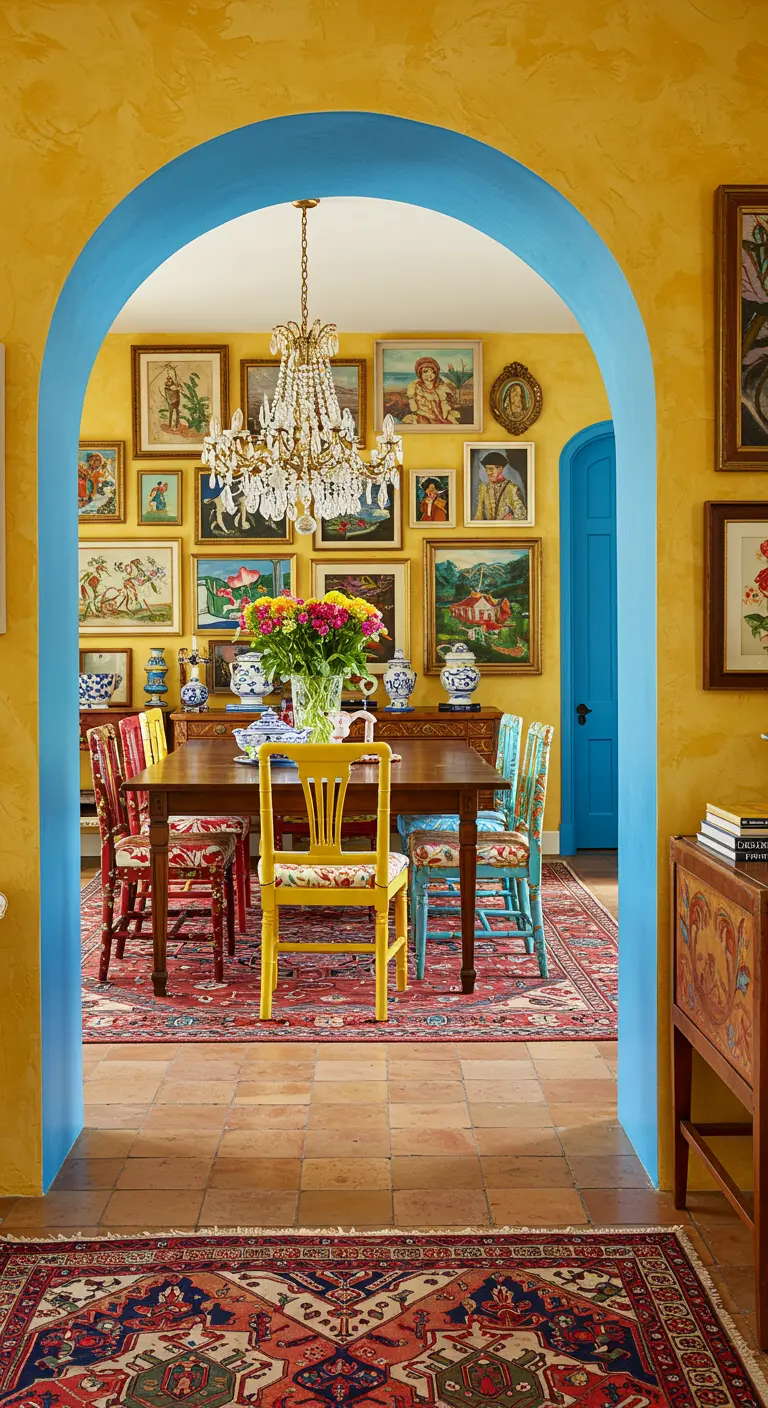
Create a dining room that radiates energy by fearlessly mixing color, pattern, and art.
Use a bold color, like this bright blue, to paint the archway itself, turning it into a vibrant frame for the room beyond.
Fill the walls with an eclectic gallery of art and pair mismatched, colorfully upholstered chairs around the table. The key is a confident and joyful approach.
An eclectic gallery wall becomes the heart of this spirited design.
21. Blend Mediterranean Warmth with Zen Simplicity
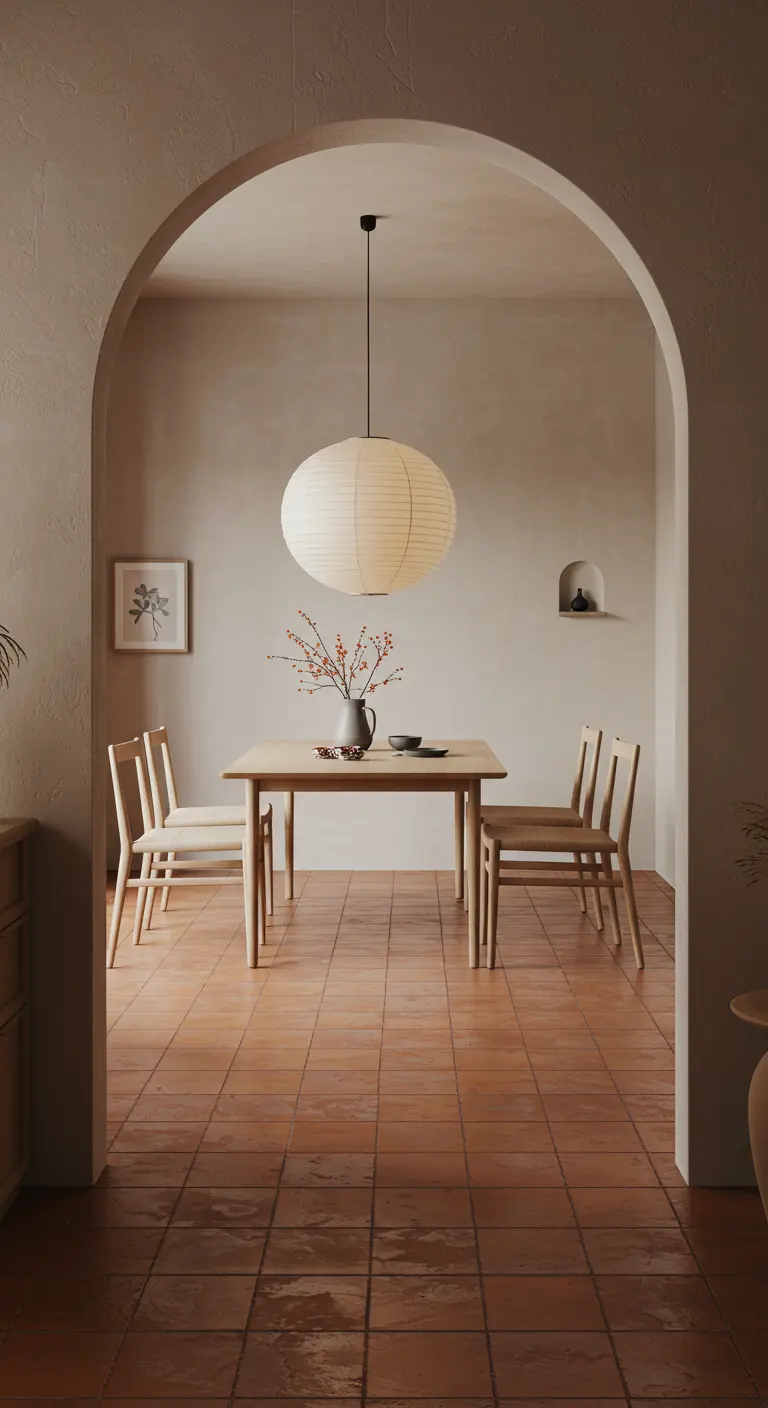
Discover a serene and sophisticated aesthetic by merging Mediterranean architecture with Japanese design principles.
Keep the foundational elements—terracotta floors and plaster arches—but adopt a minimalist philosophy for furnishings.
A simple, light wood table and chairs, paired with a delicate paper lantern, create a feeling of calm and balance.
This fusion, often seen in Japandi style kitchens, celebrates natural materials and uncluttered living.
22. Use Tile as a Bold, Graphic Statement

Instead of a simple coat of paint, wrap your archway and surrounding walls in traditional patterned tiles, like Portuguese azulejos.
This transforms a simple architectural feature into a powerful, graphic statement that becomes the focal point of the entire area.
Keep the furniture classic and sturdy—like a dark wood table and rush-seat chairs—to ground the intricate pattern of the tile.
Using bold, graphic tiles is a commitment, but one that delivers incredible character and a deep sense of place.
23. Frame an Expansive View with a Modern Arch
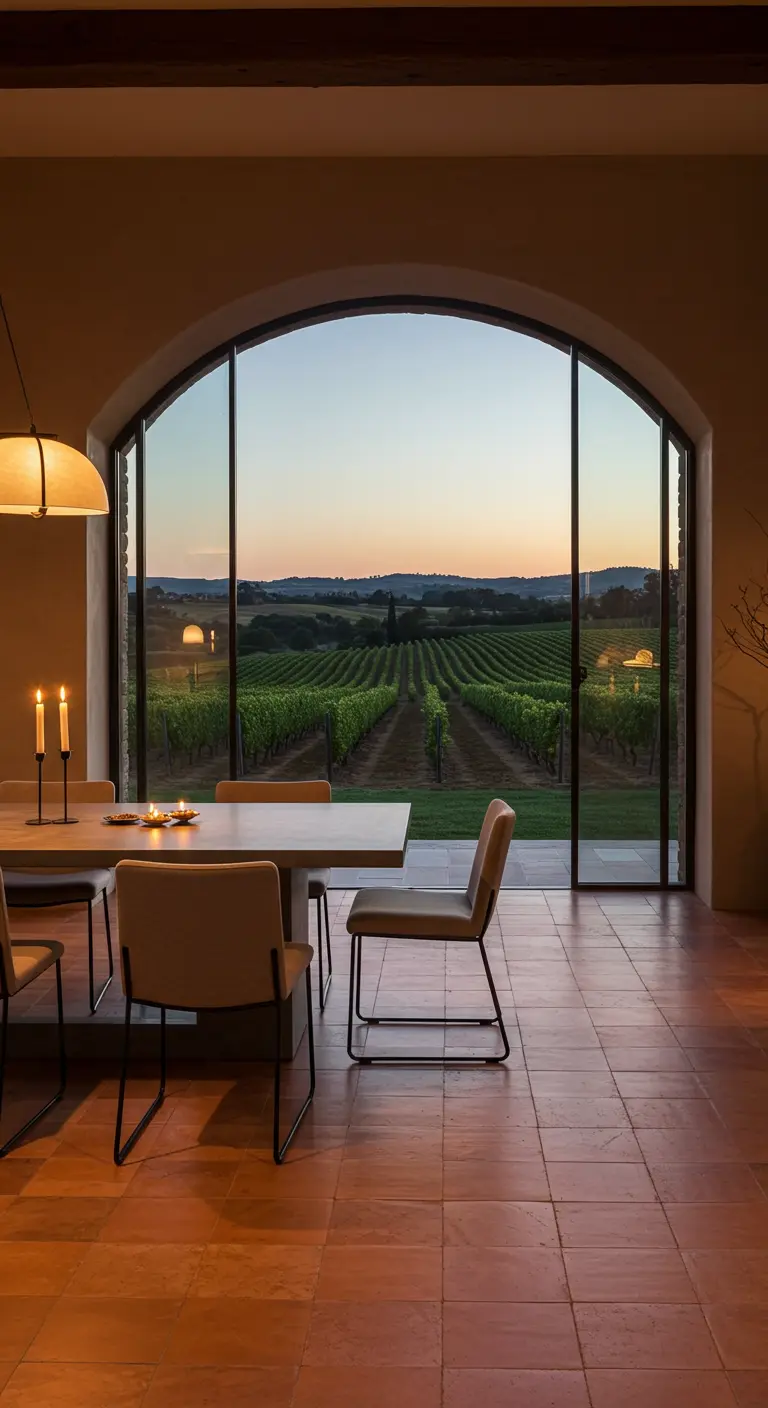
When designing around a breathtaking view, the window is everything.
A massive, steel-framed arched window offers a modern, clean-lined interpretation of the classic form, perfectly framing the rolling hills of a vineyard.
Inside, the decor should be minimal and low-profile to avoid obstructing the vista.
A simple table, comfortable modern chairs, and soft, ambient candlelight ensure the focus remains outward, celebrating the beauty of the vineyard landscape.
24. Extend the Living Space with a Loggia
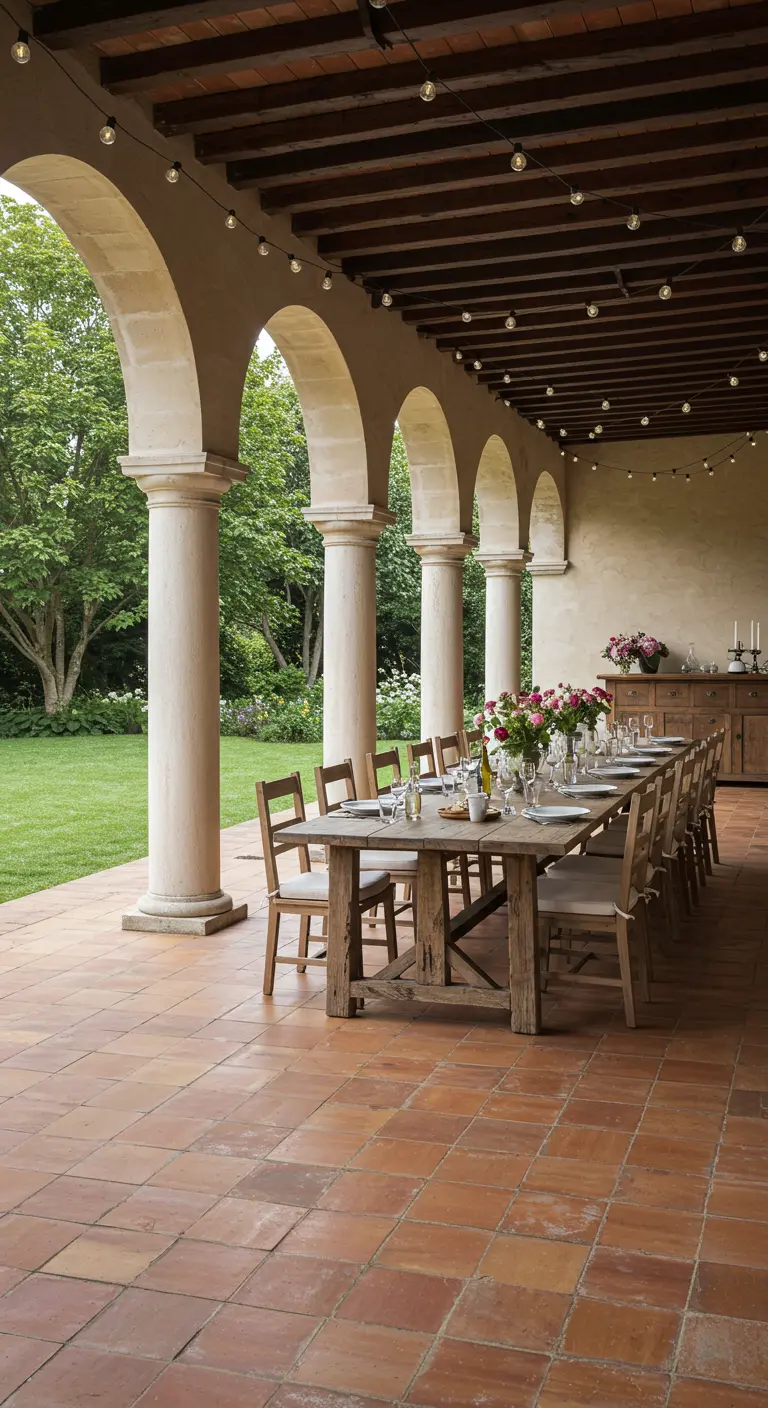
Create the ultimate indoor-outdoor dining experience with a covered loggia or patio.
The series of arches and substantial columns provides a sense of enclosure and architectural grace, while remaining open to the garden.
Furnish it like an interior room with a sturdy trestle table and proper chairs, and hang string lights from the beamed ceiling for magical evening ambiance.
This is alfresco dining at its most elegant and comfortable.
25. Create a Moody, Scholarly Atmosphere
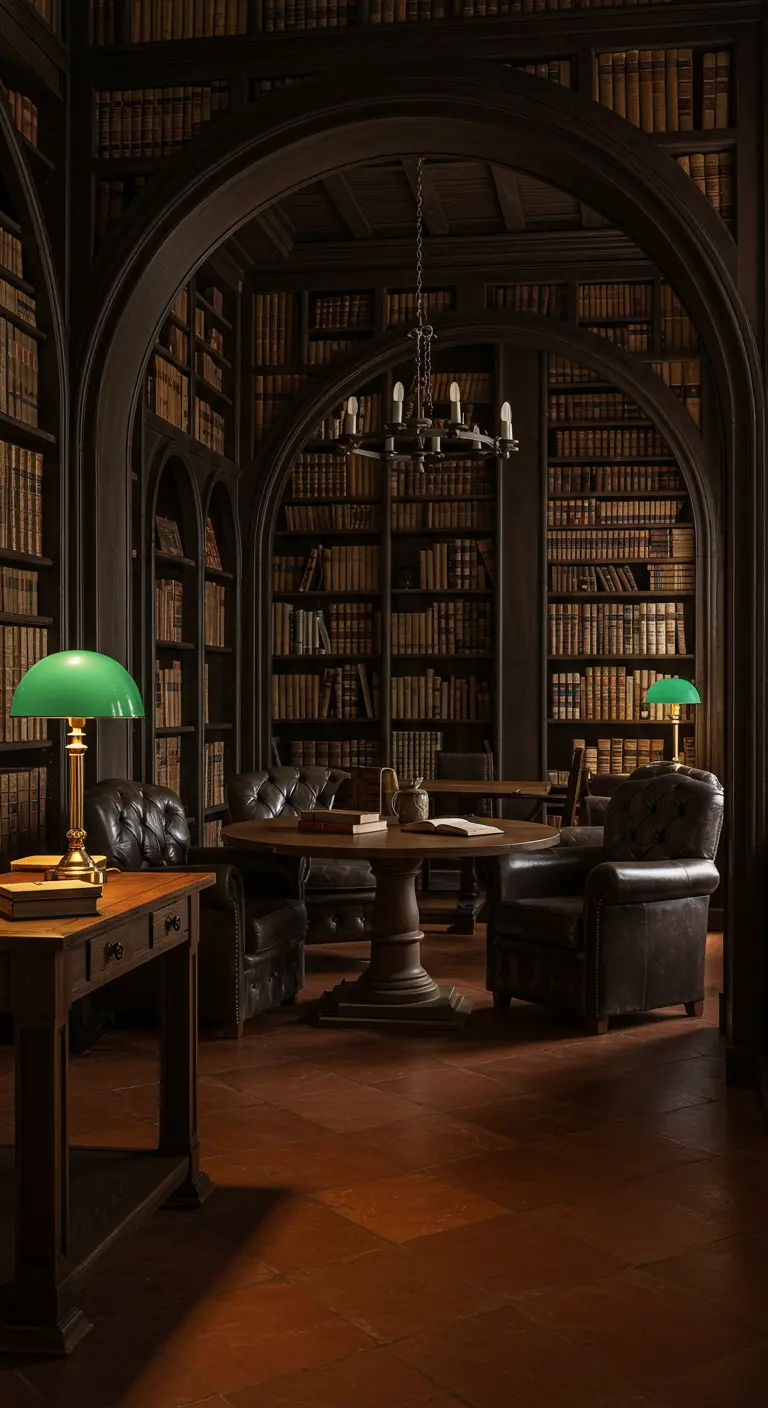
Merge the functions of dining room and library for a space that feels cozy, intellectual, and deeply personal.
Line the walls with floor-to-ceiling bookshelves, letting the books themselves provide texture and color.
Swap traditional dining chairs for comfortable, tufted leather armchairs around a round pedestal table, encouraging guests to linger long after the meal is over.
This design creates sophisticated, multipurpose rooms perfect for dining, reading, or quiet conversation.
26. Let Your Collection Become the Decor
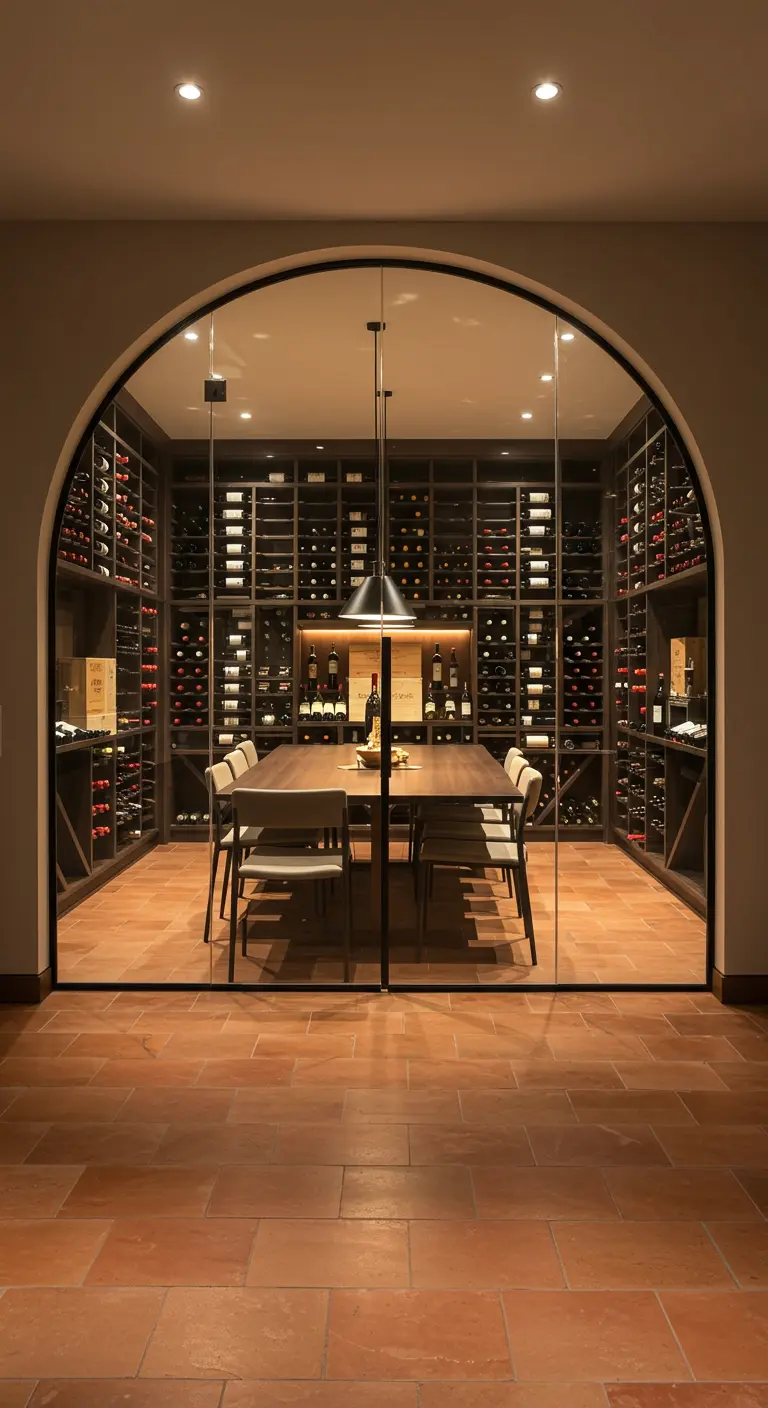
For the wine enthusiast, turn your collection into a stunning, functional backdrop for your dining area.
Enclosing a wine cellar behind a floor-to-ceiling glass wall creates a dramatic, jewel-box effect that is both practical and visually impressive.
The sleek, modern dining furniture inside the cellar offers a clean contrast to the rustic terracotta floors outside.
The overall effect is one of urban minimalist sophistication meeting traditional taste.
27. Define a Nook with Bold Wallpaper
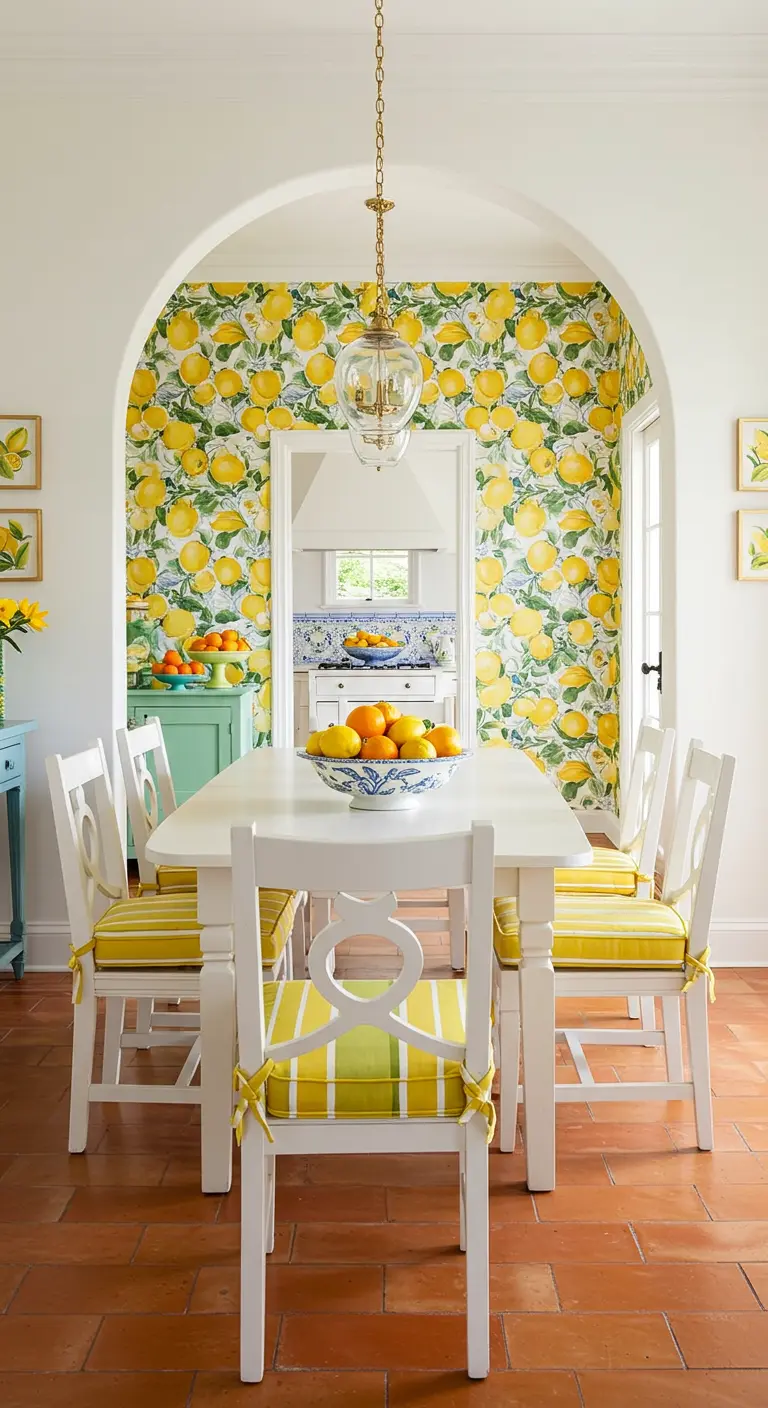
Use vibrant, patterned wallpaper to visually separate and define a smaller dining area within a larger space.
Here, a cheerful lemon-print wallpaper creates a charming, dedicated breakfast nook that feels like its own room.
The white furniture and trim provide a crisp border, making the pattern pop, while the yellow-striped cushions tie the whole playful look together.
Using a graphic wallpaper is a high-impact way to add personality to a compact zone.
28. Draw the Eye Upward with Exposed Beams
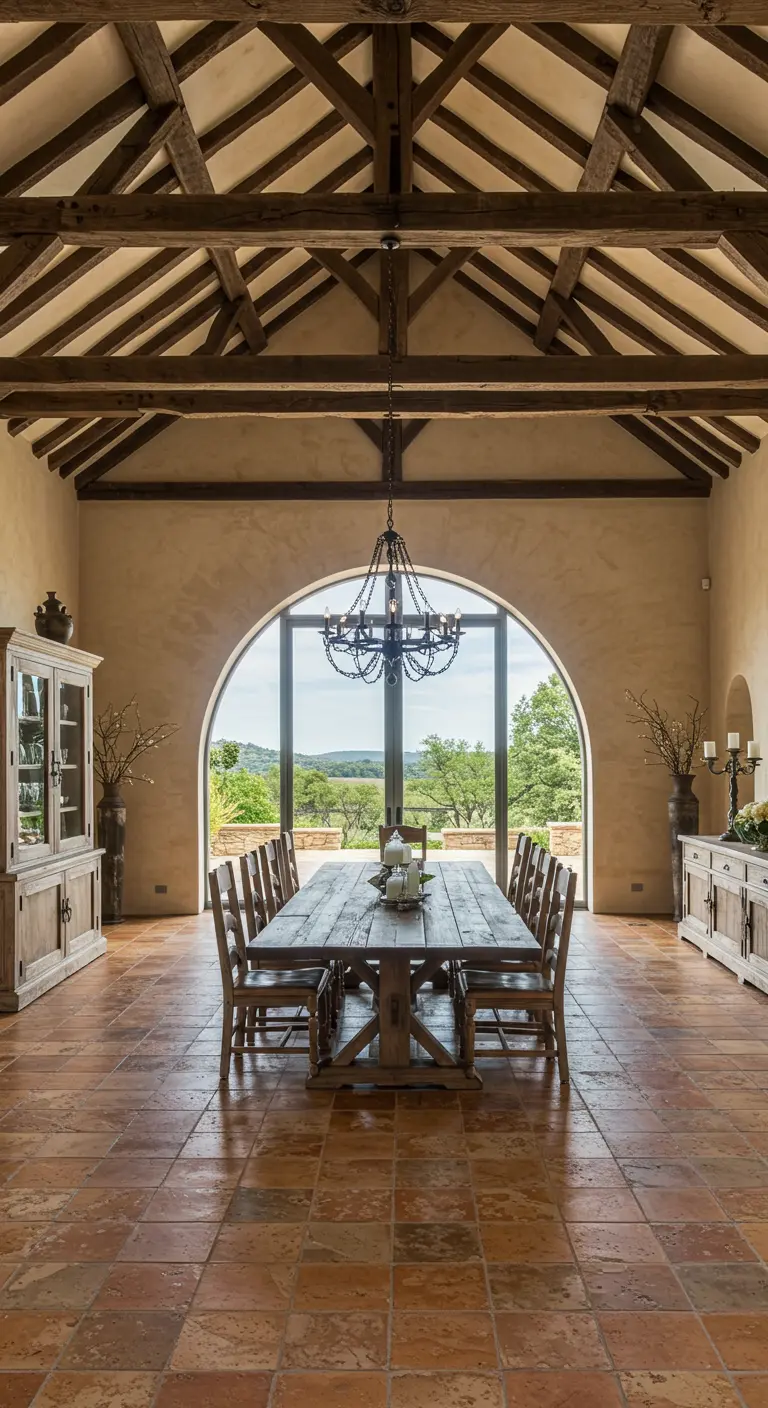
In a room with high ceilings, an exposed truss and beam system is a spectacular architectural feature.
The intricate woodwork draws the eye upward, emphasizing the volume and height of the space, while the natural wood adds immense warmth and character.
This powerful overhead element helps to ground the large room, preventing it from feeling cavernous and making the dining area below feel more intimate.
This technique is a cornerstone of rustic barn-chic design.
29. Maximize Comfort with a Built-In Banquette
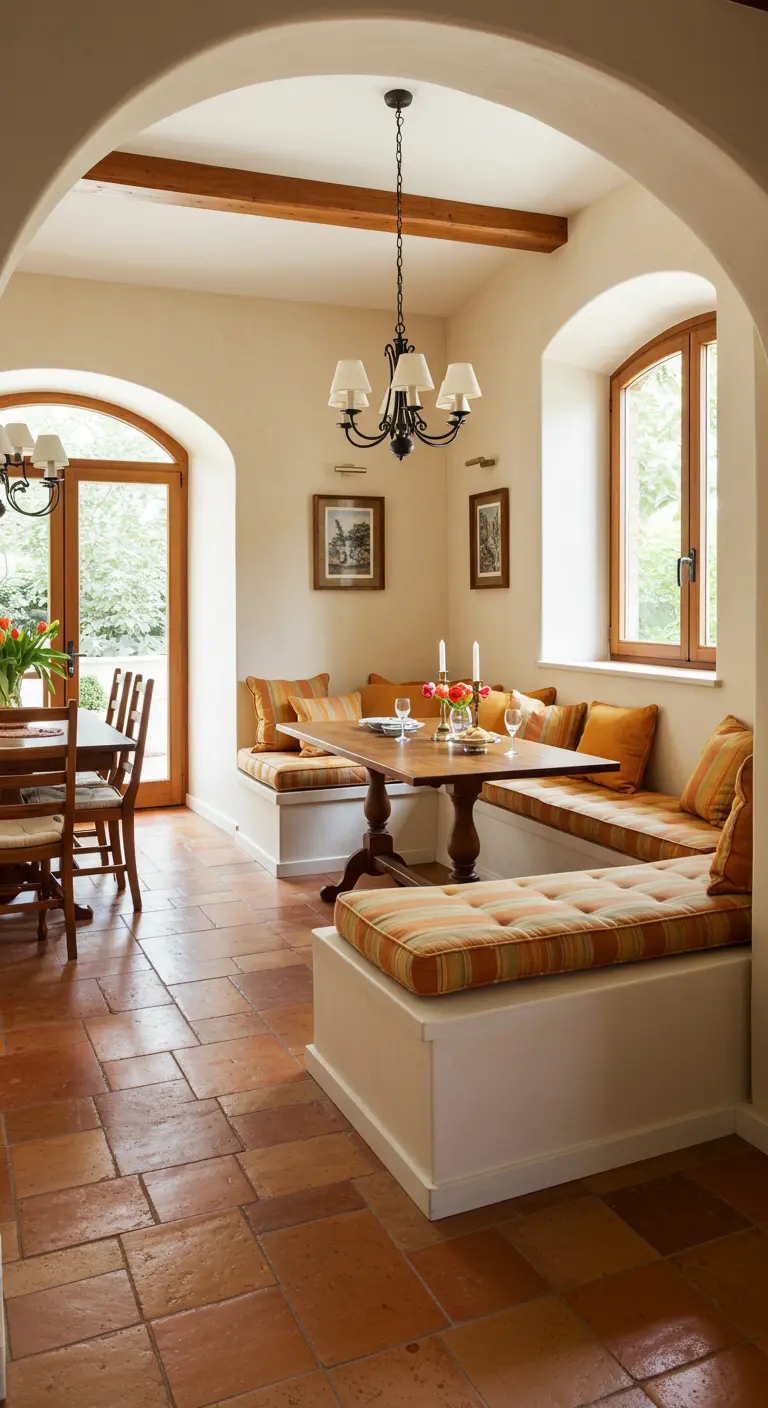
For a cozy and space-efficient dining solution, consider a built-in banquette.
A U-shaped banquette can accommodate more people than traditional chairs and creates a comfortable, café-like atmosphere that encourages casual meals and conversation.
Plush, striped cushions add pattern and comfort, softening the built-in structure. This is one of the smartest layout ideas for making the most of your square footage.
30. Juxtapose Classic Arches with Modern Transparency
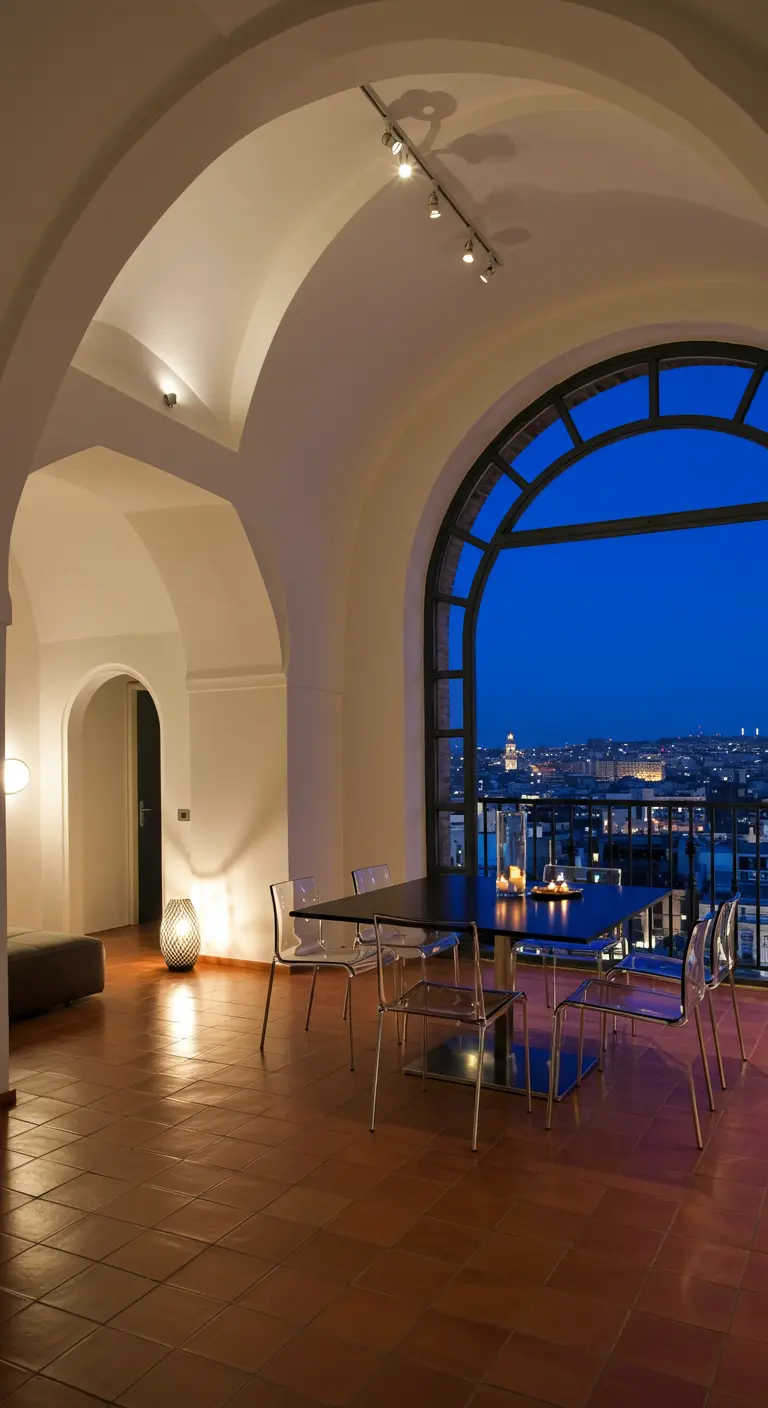
Don’t let your furniture block a stunning city view.
In this modern apartment, transparent acrylic chairs are a brilliant choice, as they provide functional seating without creating any visual clutter.
They allow the eye to travel right through them to the dramatic arched window and the sparkling city lights beyond.
This use of reflective or transparent surfaces is a key strategy for making a space feel larger and more open.
31. Celebrate the Beauty of Imperfection
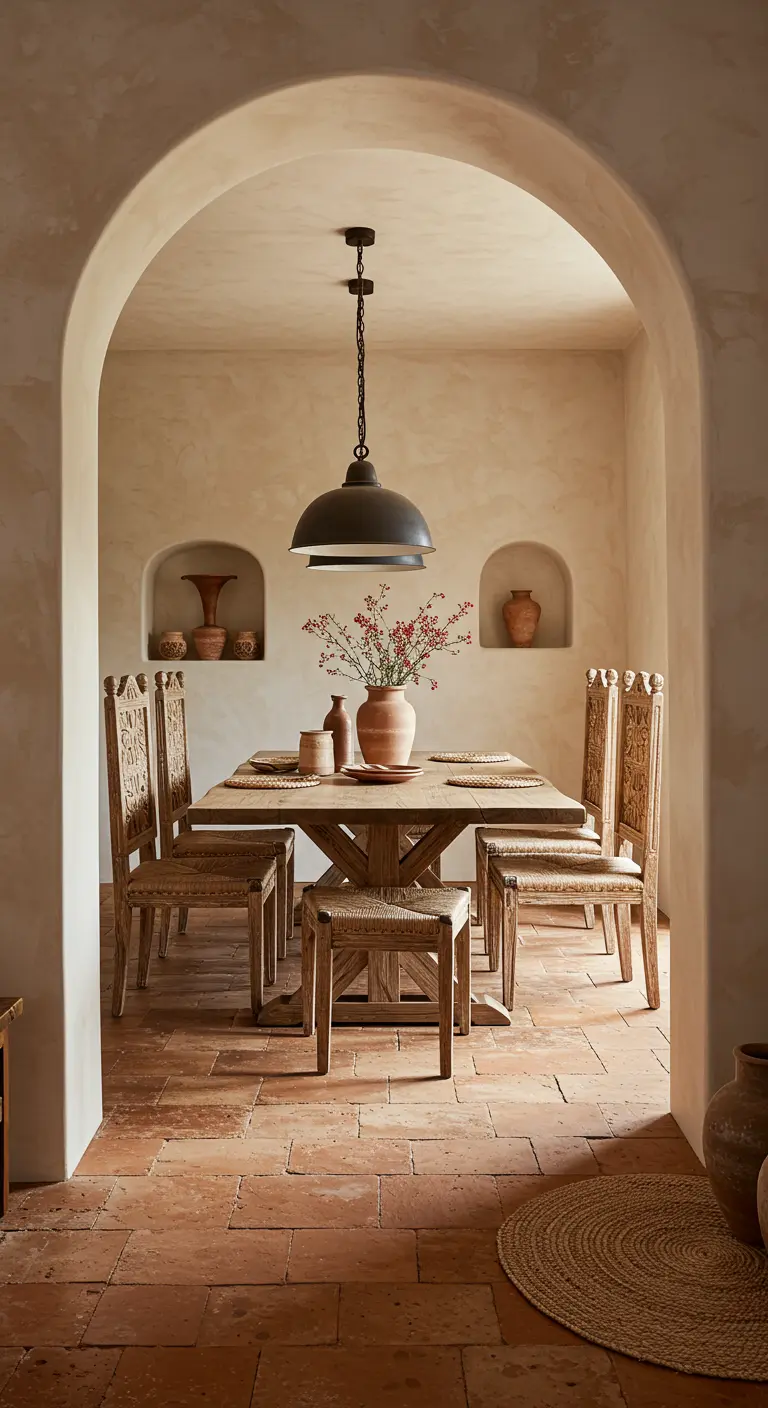
Create a space with soul by embracing materials that show the hand of the maker.
Rough, hand-troweled plaster walls, intricately carved wooden chairs, and rustic terracotta pottery in arched niches all contribute to a feeling of history and authenticity.
This Wabi-Sabi approach finds beauty in natural imperfections and textures, creating a calm and deeply resonant atmosphere.
It’s a philosophy central to serene, Japandi-style interiors, which prioritize natural, tactile surfaces.
